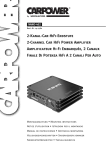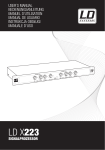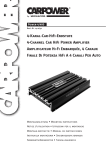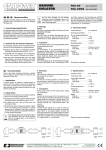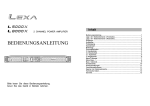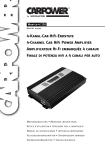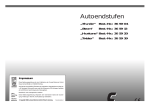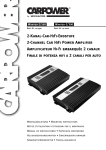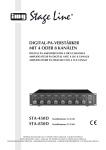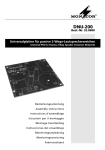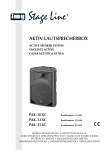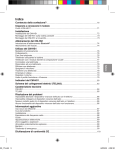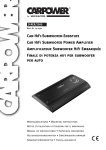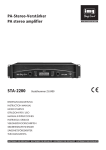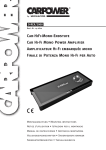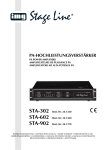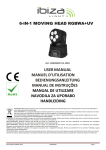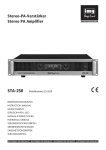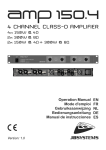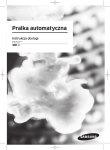Download Manuales de instrucciones
Transcript
NANO-404 Best.-Nr. 14.2790 4-Kanal-Car-HiFi-Endstufe 4-Channel Car HiFi Power Amplifier Amplificateur Hi-Fi Embarquée, 4 Canaux Finale Di Potenza HiFi A 4 Canali Per Auto Montageanleitung • Mounting instructions Notice d’utilisation • Istruzioni per il montaggio Manual de instrucciones • Instrukcja montazowa Veiligheidsvoorschriften • Sikkerhedsoplysninger Säkerhetsföreskrifter • Turvallisuudesta D Vor der Montage ... A Wir wünschen Ihnen viel Spaß mit dem neuen Gerät von CARPOWER. Bitte lesen Sie diese Montageanleitung vor dem Betrieb gründlich durch. Die Anleitung soll Ihnen eine schnelle und einfache Montage ermöglichen. Sie finden dazu hier alle nötigen Informationen. Durch die Beachtung der Anleitung werden außerdem eventuelle Schäden am Gerät durch unsachgemäße Montage vermieden. Heben Sie die Anleitung für ein späteres Nachlesen auf. We wish you much pleasure with the new unit by CARPOWER. Please read these operating instructions carefully prior to operating the unit. With these operating instructions a quick and easy mounting will be possible. You will find all necessary information here. By following these instructions possible damage to the unit due to improper mounting will be prevented. Please keep the operating instructions for later use. Der deutsche Text beginnt auf der Seite 4. The English text starts on page 7. CH GB Prior to Mounting ... F Avant toute installation ... B Nous vous souhaitons beaucoup de plaisir à utiliser cet appareil CARPOWER. Lisez ce mode dʼemploi entièrement avant toute utilisation. Cette notice a pour objectif de faciliter le montage. Vous y trouverez toutes les informations nécessaires. En outre, en respectant les conseils donnés, vous éviterez tout mauvais montage et donc dʼendommager lʼappareil. Conservez la notice pour pouvoir vous y reporter ultérieurement. Vi auguriamo buon divertimento con il vostro nuovo apparecchio CARPOWER. Leggete attentamente le istruzioni prima di mettere in funzione lʼapparecchio. Le istruzioni che contengono tutte le informazioni necessarie Vi permettono un montaggio rapido e semplice. Rispettando quanto spiegato nelle istruzioni evitate eventuali danni allʼapparecchio in seguito ad un montaggio non a regola dʼarte. Conservate le istruzioni per poterle consultare anche in futuro. La version française se trouve page 10. Il testo italiano inizia a pagina 13. CH E NL B S Antes del montaje … I PL Prima del montaggio ... Przed uruchomieniem ... Tenemos de agradercerle el haber acquirido un equipo CARPOWER y le deseamos un agradable a montar este equipo fácilmente. Por favor, lea esta manual de instrucciones atentamente antes de hacer funcionar el aparato. Todos los informaciones necesarios están incluidos. Para observar las instrucciones daños por un montaje inadecuado están evitados. Por favor, guarde las instrucciones para una futura utilización. Życzymy Państwu zadowolenia z nowego produktu CARPOWER. Dzięki tej instrukcji montażu, będą państwo w stanie poznać wszystkie funkcje tego urządzenia. Dzięki tej instrukcji obsługi będą Państwo w stanie poznać wszystkie funkcje urządzenia. Stosując się do instrukcji unikną państwo błędów i ewentualnego uszkodzenia urządzenia na skutek nieprawidłowego użytkowania. Prosimy zachować instrukcję. El texto en español empieza en la página 16. Tekst polski zaczyna się na stronie 19. Voordat u inschakelt ... DK Inden De tænder for apparatet ... Wij wensen u veel plezier met uw nieuw toestel van CARPOWER. Lees de veiligheidsvoorschriften, alvorens het toestel in gebruik te nemen. Door de veiligheidsvoorschriften op te volgen zal een slechte werking vermeden worden, en zal een eventueel letsel aan uzelf en schade aan uw toestel tengevolge van onzorgvuldig gebruik worden voorkomen. Vi ønsker Dem god fornøjelse med Deres nye CARPOWER apparat. Læs oplysningerne for en sikker brug af apparatet før ibrugtagning. Følg sikkerhedsoplysningerne for at undgå forkert betjening og for at beskytte Dem og Deres apparat mod skade på grund af forkert brug. Gem venligst denne betjeningsvejledning til senere brug. U vindt de veiligheidsvoorschriften op pagina 22. Du finder sikkerhedsanvisningen på side 22. Förskrift FIN Ennen virran kytkemistä … Vi önskar dig mycket nöje med din nya enhet från CARPOWER. Läs gärna säkerhetsinstruktionerna innan du använder enheten. Genom att följa säkerhetsinstruktionerna kan många problem undvikas, vilket annars kan skada enheten. Spara instruktionerna för framtida användning. Toivomme, että uusi CARPOWER laitteesi tuo sinulle paljon iloa ja hyötyä. Ole hyvä ja lue käyttöohjeet ennen laitteen käyttöönottoa. Luettuasi käyttöohjeet voit käyttää laitetta turvallisesti ja vältyt laitteen väärinkäytöltä. Ole hyvä ja säilytä käyttöohjeet myöhempää tarvetta varten. Du finner säkerhetsinstruktionerna på sidan 23. Turvallisuusohjeet löytyvät sivulta 23. www.carpower.com 2 1 2 3 FRONT 2 L R L 1 REAR R GAIN GAIN L 7 8 POWER FUSE GREEN L BATT REM GND PROTECT HIGH INPUT L MAX L R BRIDGED MIN RED MAX R R 50 Hz 500 LPF INPUT L GND R R BRIDGED X-OVER 4 FULL HPF 5 LPF FULL -404 HIGH INPUT HPF 50 Hz 500 X-OVER 6 INPUT 5 HQ L GND R L R L GAIN HIGH INPUT L MAX R BRIDGED L R BRIDGED MIN MAX R R 50 Hz 500 LPF L GND R Speaker L min. 2 Ω L L MIN INPUT FULL X-OVER HPF LPF AMPLIFIER 9 SPEAKER F L SPEAKER F R L R Speaker R min. 2 Ω HIGH INPUT HPF 50 Hz 500 FULL INPUT X-OVER L GND R REM Front L R Tre Bass Rear R TP 1 3 4 5 6 7 L FM AM CD 2 Menu 8 On = 12V EJECT Speaker L min. 2 Ω R L GAIN HIGH INPUT L R BRIDGED L R BRIDGED MIN MAX R R 50 Hz 500 LPF L GND R Speaker L min. 2 Ω L MAX INPUT FULL X-OVER HPF LPF D GB F I NL E PL 4-Kanalbetrieb 4-channel operation Mode 4 canaux Funzionamento a 4 canali 4-kanaals werking Modo 4 canales Praca czterokanałowa D GB F I NL E PL Aktiver 2-Wegebetrieb Active 2-way operation Mode actif 2 voies Funzionamento attivo a 2 vie Actieve 2-kanaals werking Funcionamiento activo de 2 vías Praca w układzie dwudrożnym aktywnym D GB F I NL E PL Alle Kanäle im Brückenbetrieb All channels in bridge operation Tous les canaux en mode bridgé Tutti i canali con funzionamento a ponte Alle kanalen in brugschakeling Todos los canales en modo punteado Wszystkie kanały w układzie mostka D GB F I NL E PL 3-Kanalbetrieb 3-channel operation Mode 3 canaux Funzionamento a 3 canali 3-kanaals werking Modo 3 canales Praca trójkanałowa Mid-high range REAR L MIN Speaker R min. 2 Ω Rear R GAIN R L CD / RADIO L SPEAKER R R SPEAKER R L 8 FRONT 10 11 Front REAR R GAIN 4-CH 4 8 FRONT 30 MIN SPEAKER F L SPEAKER F R R L Speaker R min. 2 Ω HIGH INPUT HPF 50 Hz 500 FULL INPUT X-OVER L GND R REM L Tre Bass TP 1 R FM AM CD 2 3 4 5 6 7 Menu 8 On = 12V EJECT Speaker L min. 2 Ω SPEAKER R L SPEAKER R R L CD / RADIO R Speaker R min. 2 Ω Bass 4 FRONT L R L REAR R GAIN GAIN MIN HIGH INPUT L MAX R BRIDGED L R BRIDGED MIN MAX R R 50 Hz 500 LPF L GND R Speaker L min. 4 Ω L L INPUT FULL X-OVER HPF LPF SPEAKER F L R SPEAKER R L R Speaker R min. 4 Ω HIGH INPUT HPF 50 Hz 500 FULL INPUT X-OVER L GND R REM L Tre Bass TP 1 R FM AM CD 2 3 4 5 6 7 Menu 8 On = 12V EJECT CD / RADIO 6 FRONT L R L REAR R GAIN GAIN MIN HIGH INPUT L MAX R BRIDGED L R BRIDGED MIN MAX R R 50 Hz 500 LPF L GND R INPUT Speaker L min. 2 Ω L L X-OVER FULL HPF LPF FULL SPEAKER F L L SPEAKER F R R Speaker R min. 2Ω HIGH INPUT HPF 50 Hz 500 INPUT X-OVER L GND R REM L Tre Bass TP 1 3 EJECT R CD 2 3 4 5 6 7 FM AM SPEAKER R L Menu 8 On = 12V CD/RADIO R Subwoofer min. 4Ω D A Auf der ausklappbaren Seite 3 finden Sie alle beschriebenen Bedienelemente und Anschlüsse. CH 1 Übersicht der Bedienelemente und Anschlüsse 1 Cinch-Buchsen INPUT für die Eingangssignale (Line-Pegel) 2 Trimmregler GAIN zur Eingangspegelanpassung 3 Lautsprecheranschlüsse 4 Hochpegel-Eingänge HIGH INPUT zum Anschluss an Lautsprecherausgänge, alternativ zu den Cinch-Eingangsbuchsen (1) 5 Trimmregler X-OVER zum Einstellen der Trennfrequenz (50 – 500 Hz) 6 Schalter X-OVER zur Auswahl der Filter: LPF für Basslautsprecher oder einen Subwoofer, Tiefpass eingeschaltet FULL für Full-Range-Lautsprecher, kein Filter eingeschaltet HPF für Mittelhochtöner, Hochpass eingeschaltet 7 Betriebsanzeige grün = ordnungsgemäßer Betrieb rot = Schutzschaltung aktiv ( Kap. 8), z. B. kurz beim Einschalten 8 Sicherung: 30 A Eine geschmolzene Sicherung nur durch eine gleichen Typs ersetzen! 9 Anschluss BATT für die Betriebsspannung +12 V 3 Vorsicht bei hohen Lautstärken VORSICHT Stellen Sie die Lautstärke nie sehr hoch ein. Extrem hohe Lautstärken können das Gehör schädigen. Das Ohr gewöhnt sich an hohe Lautstärken und empfindet sie nach einiger Zeit als nicht mehr so hoch. Erhöhen Sie darum eine einmal hoch eingestellte Lautstärke nach der Gewöhnung nicht weiter. Während des Autofahrens dürfen Signaltöne z. B. von einem Rettungswagen, nicht durch eine zu hohe Lautstärke der Car-HiFi-Anlage übertönt werden. Bei ausgeschaltetem Motor sollte die Car-HiFiAnlage nicht längere Zeit mit hoher Lautstärke betrieben werden. Die Autobatterie wird schnell entladen und liefert dann eventuell nicht mehr genügend Energie zum Starten. 4 Einsatzmöglichkeiten Diese kompakte Endstufe NANO-404 ist speziell für Car-HiFi-Anlagen konzipiert und kann vier Full-Range-Lautsprecher (2- oder 3-Wege-Lautsprecher) antreiben. Durch die integrierten Frequenzweichen lässt sich auch ein aktives 2-Wege-System mit zwei Mittelhochtönern und zwei Basslautsprechern oder einem Subwoofer realisieren (Bi-Amping). Um eine größere Ausgangsleistung zu erhalten, können jeweils zwei Kanäle im Brückenbetrieb einen Lautsprecher antreiben. 5 Montage 10 Steuereingang REM zum Einschalten der Endstufe über eine 12-V-Spannung Bei der Auswahl des Montageplatzes unbedingt die folgenden Punkte beachten: 11 Masseanschluss GND G 2 Sicherheitshinweise Die Endstufe entspricht der Kfz-Richtlinie. Die Prüfnummer ist auf dem Gerät angegeben. WARNUNG Beim Anschluss der Car-HiFiEndstufe an die Autobatterie ist besondere Sorgfalt geboten. Bei Kurzschlüssen können gefährlich hohe Ströme fließen. Schrauben Sie deshalb unbedingt vor dem Anschluss die Minusklemme der Autobatterie ab. Die Endstufe muss fest und fachgerecht an einer mechanisch stabilen Stelle im Fahrzeug montiert werden, damit sie sich nicht löst und zu einem gefährlichen Geschoss wird. Während des Betriebs kann das Gerät heiß werden. Platzieren Sie darum keine hitzeempfindlichen Gegenstände in der Nähe und berühren Sie die Endstufe nicht während des Betriebs. G G Verwenden Sie für die Reinigung nur ein trockenes, weiches Tuch, auf keinen Fall Chemikalien oder Wasser. Wird das Gerät zweckentfremdet, nicht richtig installiert, falsch bedient oder nicht fachgerecht repariert, kann keine Haftung für daraus resultierende Sach- oder Personenschäden und keine Garantie für das Gerät übernommen werden. Soll das Gerät endgültig aus dem Betrieb genommen werden, übergeben Sie es zur umweltgerechten Entsorgung einem örtlichen Recyclingbetrieb. 4 Das 12-V-Stromversorgungskabel von der Batterie zur Car-HiFi-Endstufe sollte so kurz wie möglich sein. Es ist günstiger, längere Lautsprecherkabel zu verwenden und dafür ein kürzeres Stromversorgungskabel. G Die Masseleitung von der Endstufe zum Fahrzeugchassis sollte ebenfalls so kurz wie möglich sein. G Um die entstehende Wärme der Car-HiFiEndstufe ableiten zu können, muss eine ausreichende Belüftung gewährleistet sein. G Wegen der beim Bremsen auftretenden Kräfte muss die Endstufe an einer mechanisch stabilen Stelle fest angeschraubt werden. Die Endstufe über die vier Bohrungen am Kühlkörper an geeigneter Stelle festschrauben. 6 Endstufe anschließen G Der Anschluss der Car-HiFi-Endstufe an das Bordnetz darf nur durch qualifiziertes Fachpersonal erfolgen. G Unbedingt vor dem Anschluss die Minusklemme der Autobatterie abschrauben, um bei einem eventuellen Kurzschluss während der Installation Schäden zu vermeiden. G Die erforderlichen Kabel so verlegen, dass deren Isolierung nicht beschädigt werden kann. Verschiedene Anschlussmöglichkeiten sind in den Abbildungen 2 – 5 auf der Seite 3 dargestellt. 6.1 Stromversorgung 6.1.1 Masseanschluss Den Masseanschluss GND (11) über ein Kabel mit einem Querschnitt von mindestens 10 mm2 (z. B. CPC-100/SW von CARPOWER) mit der Masse des Autos oder besser direkt mit der Minusklemme der Autobatterie verbinden. Hinweise 1. Bei Verwendung der Karosserie als Masseanschluss muss die verwendete Stelle einen guten elektrischen Kontakt zur Hauptkarosserie aufweisen (z. B. durch ausreichend viele Schweißpunkte). Eventuell vorhandener Lack am Kontaktpunkt muss vollständig entfernt werden. 2. Zur Vermeidung von Masseschleifen muss die Masse des Autoradios an die Stelle gelegt werden, an der auch die Endstufe an Masse liegt. 6.1.2 Betriebsspannung Den Anschluss BATT (9) über ein Kabel mit der Plusklemme der Autobatterie verbinden. Um den Spannungsverlust durch das Kabel gering zu halten, sollte ein Kabel mit einem Mindestquerschnitt von 10 mm2 verwendet werden (z. B. CPC-100/RT von CARPOWER). Um die neu verlegte 12-V-Leitung gegen einen Kurzschluss abzusichern, muss eine Vorsicherung in unmittelbarer Nähe der Batterie zwischengesetzt werden (max. Kabellänge zur Batterie 20 cm). Den Sicherungswert entsprechend der Stromaufnahme aller an der 12-V-Leitung angeschlossenen Geräte wählen. 6.1.3 Steuerspannung zum Einschalten Die Car-HiFi-Endstufe wird durch eine Steuerspannung von +12 V am Anschluss REM (10) ein- und ausgeschaltet. Den Anschluss REM mit dem 12-V-Schaltausgang vom Autoradio verbinden (Anschluss für eine Motorantenne, eventuell mit der Motorantenne parallel schalten). 6.2 Eingänge Die Signaleingänge INPUT (1) der Endstufe über Cinch-Kabel mit den Line-Ausgängen am Autoradio (oder einer anderen Signalquelle) verbinden. Sind am Autoradio jedoch keine Line-Ausgänge vorhanden, können alternativ die Lautsprecherausgänge des Autoradios mit den Hochpegel-Eingängen HIGH INPUT (4) der Endstufe verbunden werden. Zwei passende Anschlusskabel liegen der Endstufe bei. Der Anschluss der Eingänge richtet sich nach der gewünschten Betriebsart der Endstufe: 6.2.1 4-Kanalbetrieb (Abb. 2) Der 4-Kanalbetrieb wird beim Einsatz von vier Full-Range-Lautsprechern (2- oder 3-Wege-Lautsprecher) benötigt. Die Ausgänge des Autoradios wie folgt mit den Eingängen der Endstufe verbinden: Front links Front rechts Rear links Rear rechts mit der Buchse FRONT L mit der Buchse FRONT R mit der Buchse REAR L mit der Buchse REAR R Sind am Autoradio keine Ausgänge für die hinteren Kanäle (Rear) vorhanden, den AutoradioAusgang des linken Kanals über ein Y-Kabel (z. B. CBA-25/SW von CARPOWER) mit den beiden Endstufen-Eingängen FRONT L und REAR L verbinden und den Ausgang des rechten Kanals über ein zweites Y-Kabel mit den beiden Eingängen FRONT R und REAR R (wie z. B. in Abb. 3 dargestellt). 6.2.2 Aktiver 2-Wegebetrieb (Abb. 3) Beim aktiven 2-Wegebetrieb mit Mittelhochtönern und Basslautsprechern wird jeder Lautsprecher von einem eigenen Verstärkerkanal angetrieben. Die Frequenzaufteilung zwischen den Mittelhochtönern und Basslautsprechern erfolgt durch die integrierten Frequenzweichen ( Kap. 7.1). Die Ausgänge des Autoradios mit den folgenden Eingängen der Endstufe verbinden: Den Ausgang des linken Kanals über ein YKabel (z. B. CBA-25/SW von CARPOWER) mit den beiden Endstufen-Eingängen FRONT L und REAR L verbinden und den Ausgang des rechten Kanals über ein zweites Y-Kabel mit den beiden Eingängen FRONT R und REAR R. 6.2.3 Brückenbetrieb (Abb. 4) Zur Erhöhung der Ausgangsleistung können die Kanäle FRONT L und FRONT R in Brückenschaltung den linken Lautsprecher antreiben sowie die Kanäle REAR L und REAR R in Brückenschaltung den rechten Lautsprecher. Dazu den Autoradio-Ausgang des linken Kanals über ein Y-Kabel (z. B. CBA-25/SW von CARPOWER) mit den beiden Endstufen-Eingängen FRONT L und FRONT R verbinden und den Ausgang des rechten Kanals über ein zweites Y-Kabel mit den beiden Eingängen REAR L und REAR R. 6.2.4 3-Kanalbetrieb (Abb. 5) Der 3-Kanalbetrieb dient zur Unterstützung von zwei Full-Range-Lautsprechern durch einen Subwoofer. Um für den Subwoofer eine höhere Leistung zu erhalten, werden die Kanäle REAR L und REAR R in Brücke geschaltet. Die Ausgänge des Autoradios wie folgt mit den Eingängen der Endstufe verbinden: linker Kanal rechter Kanal Subwoofer L Subwoofer R auf Kanal FRONT L auf Kanal FRONT R auf Kanal REAR L auf Kanal REAR R Sind am Autoradio keine Ausgänge für einen Subwoofer-Verstärker vorhanden, den Ausgang des linken Kanals über ein Y-Kabel (z. B. CBA25/SW von CARPOWER) mit den beiden Endstufen-Eingängen FRONT L und REAR L verbinden und den Ausgang des rechten Kanals über ein zweites Y-Kabel mit den beiden Eingängen FRONT R und REAR R (siehe Abb. 5). 6.3 Lautsprecher Es lassen sich Full-Range-Lautsprecher (2- oder 3-Wege-Lautsprecher), Mittelhochtöner, Basslautsprecher oder Subwoofer betreiben. Wichtig! Alle Lautsprecher müssen 2-polig angeschlossen werden, d. h. ohne gemeinsamen Masseanschluss. Bei der Auswahl geeigneter Lautsprecher unbedingt deren mechanische und elektrische Belastbarkeit im Zusammenhang mit der genutzten Endstufenleistung berücksichtigen ( Technische Daten, Seite 6). Die größte Ausgangsleistung wird beim Anschluss von 2-Ω-Lautsprechern oder einer Lautsprechergruppe mit einer Gesamtimpedanz von 2 Ω pro Kanal erreicht (z. B. zwei 4-ΩLautsprecher parallel geschaltet). Es können jedoch auch einzelne 4-Ω-Lautsprecher angeschlossen werden, wobei sich die Ausgangsleistung verringert. Achtung! Beim Brückenbetrieb (Kap. 6.3.3 und 6.3.4) darf die Impedanz der Lautsprecher bzw. die Gesamtimpedanz von Lautsprechergruppen 4 Ω nicht unterschreiten! Die Lautsprecher über das beiliegende Anschlusskabel mit der Buchse SPEAKER (3) verbinden. Der Anschluss richtet sich nach der gewünschten Betriebsart der Endstufe: 6.3.1 4-Kanalbetrieb Siehe auch Abb. 2. SPEAKER F SPEAKER F SPEAKER F SPEAKER F L⊕ L⊖ R⊕ R⊖ = Pluspol = Minuspol = Pluspol = Minuspol Lautsprecher vorne links Lautsprecher vorne links Lautsprecher vorne rechts Lautsprecher vorne rechts SPEAKER R SPEAKER R SPEAKER R SPEAKER R L⊕ L⊖ R⊕ R⊖ = Pluspol = Minuspol = Pluspol = Minuspol Lautsprecher hinten links Lautsprecher hinten links Lautsprecher hinten rechts Lautsprecher hinten rechts 6.3.2 Aktiver 2-Wegebetrieb Siehe auch Abb. 3. SPEAKER F SPEAKER F SPEAKER F SPEAKER F L⊕ L⊖ R⊕ R⊖ = Pluspol = Minuspol = Pluspol = Minuspol linker Mittelhochtöner linker Mittelhochtöner rechter Mittelhochtöner rechter Mittelhochtöner SPEAKER R SPEAKER R SPEAKER R SPEAKER R L⊕ L⊖ R⊕ R⊖ = Pluspol = Minuspol = Pluspol = Minuspol linker Basslautsprecher linker Basslautsprecher rechter Basslautsprecher rechter Basslautsprecher 6.3.3 Brückenbetrieb Beim Anschluss die Beschriftung BRIDGED beachten, siehe auch Abb. 4. SPEAKER F SPEAKER F SPEAKER F SPEAKER F L⊕ L⊖ R⊕ R⊖ = Pluspol linker Lautsprecher = bleibt frei = bleibt frei = Minuspol linker Lautsprecher SPEAKER R SPEAKER R SPEAKER R SPEAKER R L⊕ L⊖ R⊕ R⊖ = Pluspol rechter Lautsprecher = bleibt frei = bleibt frei = Minuspol rechter Lautsprecher 6.3.4 3-Kanalbetrieb Siehe auch Abb. 5. SPEAKER F SPEAKER F SPEAKER F SPEAKER F L⊕ L⊖ R⊕ R⊖ = Pluspol = Minuspol = Pluspol = Minuspol SPEAKER R SPEAKER R SPEAKER R SPEAKER R L⊕ L⊖ R⊕ R⊖ = Pluspol Subwoofer = bleibt frei = bleibt frei = Minuspol Subwoofer linker Lautsprecher linker Lautsprecher rechter Lautsprecher rechter Lautsprecher 7 Inbetriebnahme Wichtig! Vor dem ersten Einschalten die Filter mit den Schaltern X-OVER (6) auswählen und die Trennfrequenzen mit den Reglern X-OVER (5) grob einstellen (Kap. 7.1), damit die Lautsprecher nicht durch einen eventuell zu großen Frequenzbereich überlastet werden. Auch sollte die komplette Verdrahtung der Endstufe noch einmal auf Richtigkeit überprüft werden. Erst danach die Minusklemme der Autobatterie wieder anschließen. 7.1 Filter auswählen und Trennfrequenzen einstellen Je nach angeschlossenem Lautsprechertyp mit den Schaltern X-OVER (6) die Filter auswählen. Der linke Schalter und die linken Regler sind zum Einstellen der Kanäle FRONT L und FRONT R, der rechte Schalter und die rechten Regler für die Kanäle REAR L und REAR R. D A CH Für Full-Range-Lautsprecher den bzw. die Schalter X-OVER in die Position FULL schieben. Die zugehörigen Kanäle geben den gesamten Frequenzbereich wieder. Die zugehörigen Regler X-OVER sind ohne Funktion. Für Mittelhochtöner den bzw. die Schalter X-OVER in die Position HPF schieben. In den zugehörigen Kanälen ist der Hochpass eingeschaltet und die tiefen Frequenzen werden damit unterdrückt. Die Trennfrequenz mit dem zugehörigen Regler X-OVER zunächst grob einstellen.* Für Basslautsprecher oder Subwoofer den bzw. die Schalter X-OVER in die Position LPF schieben. In den zugehörigen Kanälen ist der Tiefpass eingeschaltet und die mittleren sowie hohen Frequenzen werden unterdrückt. Die Trennfrequenz mit dem zugehörigen Regler X-OVER zunächst grob einstellen.* 7.2 Pegel einstellen Tipp Um Störeinstrahlungen durch die Autoelektrik so gering wie möglich zu halten, sollte der Ausgangspegel der Signalquelle min. 1,5 V betragen. 1) Zuerst zur Grundeinstellung die beiden Regler GAIN (2) ganz nach links in die Position MIN drehen. 2) Die Car-HiFi-Anlage komplett einschalten. Die Betriebsanzeige (7) leuchtet kurz rot, dann grün. Leuchtet sie nicht auf oder nur rot, siehe Kap. 8. 3) Die Signalquelle, z. B. das Autoradio, auf maximale, nicht verzerrende Lautstärke einstellen. 4) Die Regler GAIN maximal so weit aufdrehen, dass keine Verzerrungen auftreten. (Der linke Regler ist zum Einstellen der Kanäle FRONT L und FRONT R, der rechte Regler für die Kanäle REAR L und REAR R.) Beim 4-Kanalbetrieb lässt sich mit den Reglern auch die Balance zwischen den vorderen und hinteren Lautsprechern einstellen, falls am Autoradio dafür kein Regler vorhanden ist. Beim aktiven 2-Wegebetrieb und beim 3Kanalbetrieb mit den Reglern einen natürlichen Klang einstellen: Sind die Bässe zu leise, die Kanäle für die Mittelhochtöner im Pegel reduzieren. Bei zu kräftigen Bässen die Lautstärke der Basskanäle bzw. des Subwoofer-Kanals verringern. 5) Sind in der Car-HiFi-Anlage weitere Endstufen eingesetzt, zur Anpassung der Lautstärke aller Kanäle untereinander die jeweils zu lauten Kanäle im Pegel reduzieren. * Zur Orientierung den Frequenzbereich der eingesetzten Lautsprecher beachten. Die Feineinstellung erfolgt nach der Pegeleinstellung mit entsprechenden Messgeräten. 5 D 8 Fehlerbeseitigung 9 Technische Daten A Ist nach dem Einschalten der Car-HiFi-Anlage kein Ton zu hören, den Fehler mithilfe der LED (7) näher lokalisieren. Ausgangsleistung max. Leistung: . . . . . . . 300 W Sinusleistung an 2 Ω: . . 4 × 60 W Sinusleistung an 4 Ω: . . 4 × 40 W Sinusleistung bei Brückenbetrieb an 4 Ω: 2 × 120 W Frequenzbereich: . . . . . . . 20 – 30 000 Hz min. Lautsprecherimpedanz 4-Kanalbetrieb: . . . . . . 2 Ω Brückenbetrieb: . . . . . . 4 Ω Eingangsempfindlichkeit Line (Cinch-Buchsen): . 0,15 – 5 V High Input: . . . . . . . . . . 2,5 – 7 V Filter (Grenzfrequenzen) Tiefpässe: . . . . . . . . . . 50 – 500 Hz, 12 dB/Okt. Hochpässe: . . . . . . . . . 50 – 500 Hz, 12 dB/Okt. Kanaltrennung: . . . . . . . . 55 dB Störabstand: . . . . . . . . . . 96 dB (A-bewertet) Klirrfaktor: . . . . . . . . . . . . < 0,07 % Stromversorgung: . . . . . . 11 – 16 V /30 A Einsatztemperatur: . . . . . 0 – 40 °C Abmessungen: . . . . . . . . . 158 × 44 × 182 mm Gewicht: . . . . . . . . . . . . . . 1,5 kg CH Die LED leuchtet nicht 1) Die Sicherung (8) der Car-HiFi-Endstufe (30 A) und die Vorsicherung an der Autobatterie überprüfen. Defekte Sicherungen auswechseln. Nur Sicherungen mit den angegebenen Werten verwenden. Auf keinen Fall einen höheren Wert einsetzen. Die Endstufe kann beschädigt werden und die Garantie erlischt. 2) Das 12-V-Stromversorgungskabel sowie das Massekabel auf korrekten Anschluss und Unterbrechung kontrollieren. 3) An der Klemme REM (10) der Endstufe messen, ob +12 V anliegt. Wenn nicht, die Leitung an der Klemme REM entfernen und vorübergehend die Klemmen REM und BATT (9) überbrücken. Schaltet die Endstufe jetzt ein, liegt der Fehler an der fehlenden Steuerspannung. Den 12-V-Schaltausgang des Autoradios und das entsprechende Anschlusskabel zur Endstufe überprüfen. Die LED leuchtet grün 1) Die Audio-Leitungen von der Signalquelle zur Car-HiFi-Endstufe überprüfen. Sind die Stecker richtig eingesteckt? Sind die Leitungen unterbrochen? Änderungen vorbehalten. 2) Die Signalquelle überprüfen. Ist die Signalquelle eingeschaltet? Sind die richtigen Ausgänge verwendet worden? Ist die Signalquelle defekt? 3) Die Lautsprecherkabel auf Unterbrechung überprüfen. 4) Die angeschlossenen Lautsprecher überprüfen. Die LED leuchtet rot Die Endstufe ist mit einer Schutzschaltung gegen Überhitzung und gegen Kurzschlüsse an den Lautsprecherausgängen gesichert. Die Schutzschaltung spricht außerdem an, wenn bei einem Defekt der Endstufe eine Gleichspannung auf die Lautsprecherausgänge gelangt und kurz zum Stummschalten beim Einschalten. Schaltet die Schutzschaltung ein, leuchtet die LED (7) rot und die Lautsprecherausgänge werden abgeschaltet. Wechselt die LED nach dem Einschalten der Endstufe nicht von Rot auf Grün oder schaltet sie während des Betriebs auf Rot um, die CarHiFi-Anlage ausschalten und die Fehlerursache beseitigen. Nach der Fehlerbeseitigung oder nach dem Abkühlen schaltet die Endstufe automatisch wieder ein. Diese Bedienungsanleitung ist urheberrechtlich für MONACOR ® INTERNATIONAL GmbH & Co. KG geschützt. Eine Reproduktion für eigene kommerzielle Zwecke – auch auszugsweise – ist untersagt. 6 All operating elements and connections can be found on the fold-out page 3. 3 Caution in Case of High Volumes CAUTION 1 Operating Elements and Connections 1 RCA jacks INPUT for the input signals (line level) 2 Trimming control GAIN for matching the input level 3 Speaker terminals 4 High level inputs HIGH INPUT for connection to speaker outputs, as an alternative to the RCA input jacks (1) 5 Trimming control X-OVER for adjusting the crossover frequency (50 – 500 Hz) 6 Switch X-OVER for selecting the filters: LPF for bass speakers or a subwoofer, low pass switched on FULL for full range speakers, no filter switched on HPF for mid-high range speakers, high pass switched on 7 Power LED green = correct operation red = protective circuit activated ( chapter 8), e. g. shortly during switching-on 8 Fuse: 30 A Only replace a blown fuse by one of the same type! 9 Terminal BATT for the operating voltage +12 V Never adjust the volume very high. Extremely high volumes may damage your hearing. The human ear gets accustomed to high volumes which do not seem to be so high any more after some time. Therefore, do not further increase a high volume which has once been adjusted after getting used to it. While driving in the car, signal sounds, e. g. by an ambulance, must not be drowned by the volume of the car HiFi system which has been adjusted too high. With the motor switched off, the car HiFi system should not be in operation at high volume for a longer period of time. The car battery will quickly be discharged, and then it may not be capable any more of supplying sufficient energy for starting the car. 4 Applications The compact power amplifier NANO-404 has especially been designed for car HiFi systems and is capable of driving four full range speakers (2-way or 3-way speakers). Due to the integrated crossover networks, it is also possible to realize an active 2-way system with two mid-high range speakers and two bass speakers or a subwoofer (bi-amping). To obtain a higher output power, two channels each in bridge operation can drive one speaker. 5 Mounting 10 Control input REM for switching on the power amplifier via a 12 V voltage When choosing the place of mounting, always observe the following items in any case: 11 Ground terminal GND G The 12 V power supply cable from the battery to the car HiFi power amplifier should be as short as possible. It is better to use longer speaker cables and a shorter power supply cable instead. G The ground cable from the power amplifier to the chassis of the car should also be as short as possible. G For carrying off the heat being generated by the car HiFi power amplifier, sufficient ventilation has to be ensured. G As forces occur during braking, the power amplifier must tightly be screwed to a mechanically stable place. 2 Safety Notes The power amplifier corresponds to the directive for automobiles. The test number is indicated on the unit. WARNING When connecting the car HiFi power amplifier to the car battery, be especially careful. In case of short circuits there may be dangerously high currents. Therefore, prior to the connection, it is indispensable to screw off the negative terminal of the car battery. The power amplifier must be mounted to a mechanically stable place in the car. It must be skilfully fixed so that it does not get loose and turn into a dangerous projectile. During operation the unit may become very hot. Therefore, do not place any objects sensitive to heat close to it and do not touch the power amplifier while in operation. G For cleaning only use a dry, soft cloth, never use chemicals or water. G No guarantee claims for the unit and no liability for any resulting personal damage or material damage will be accepted if the unit is used for other purposes than originally intended, if it is not correctly installed or operated, or not repaired in an expert way. If the unit is to be put out of operation definitively, take it to a local recycling plant for a disposal which is not harmful to the environment. Tightly screw the power amplifier at a suitable place via the four drill holes at the heat sink. 6 Connection of the Power Amplifier G The connection of the car HiFi power amplifier to the electric system of the car must only be carried out by qualified, specialized personnel. G To prevent damage in case of a possible short circuit during installation, prior to the connection it is indispensable to screw off the negative terminal of the car battery. G Lay the necessary cables so that their insulation cannot be damaged. Various connecting possibilities are shown in figs. 2 to 5 on page 3. 6.1 Power supply GB 6.1.1 Ground connection Connect the ground terminal GND (11) via a cable with a minimum cross section of 10 mm2 (e. g. CPC-100 / SW from CARPOWER) to the ground of the car or better directly to the negative terminal of the car battery. Notes 1. When using the chassis as a ground connection, the place used must have a good electrical contact to the main chassis (e. g. by a sufficient number of welding points). Any lacquer at the point of contact must completely be removed. 2. To prevent ground loops, the ground of the car radio must be applied at the place where also the power amplifier is grounded. 6.1.2 Operating voltage Connect the terminal BATT (9) via a cable to the positive terminal of the car battery. To keep the voltage loss by the cable as low as possible, a cable with a minimum cross section of 10 mm2 should be used (e. g. CPC-100 / RT from CARPOWER). To protect the newly laid 12 V cable against a short circuit, insert an additional fuse very close to the battery (max. cable length to the battery 20 cm). Select the fuse value according to the power consumption of all units connected to the 12 V cable. 6.1.3 Control voltage for switching-on The car HiFi power amplifier is switched on and off by a control voltage of +12 V at the terminal REM (10). Connect the terminal REM to the 12 V control output of the car radio (connection for a motor antenna, if necessary, to be connected in parallel to the motor antenna). 6.2 Inputs The signal inputs INPUT (1) of the power amplifier are connected via RCA cables to the line outputs at the car radio (or another signal source). However, if the car radio is not equipped with line outputs, as an alternative the speaker outputs of the car radio can be connected to the high level inputs HIGH INPUT (4) of the power amplifier. Two matching connection cables are supplied with the power amplifier. The connection of the inputs depends on the desired operating mode of the power amplifier: 6.2.1 4-channel operation (fig. 2) The 4-channel operation is required when using four full range speakers (2-way or 3-way speakers). Connect the outputs of the car radio to the inputs of the power amplifier as follows: front left front right rear left rear right to the jack FRONT L to the jack FRONT R to the jack REAR L to the jack REAR R If the car radio is not equipped with outputs for the rear channels, connect the output of the car radio of the left channel via a Y cable (e. g. CBA25 / SW from CARPOWER) to the two inputs FRONT L and REAR L of the power amplifier and the output of the right channel via a second Y cable to the two inputs FRONT R and REAR R (e. g. as shown in fig. 3). 6.2.2 Active 2-way operation (fig. 3) For active 2-way operation with mid-high range speakers and bass speakers, each speaker is driven by an individual amplifier channel. The frequency ranges between the mid-high range 7 GB speakers and the bass speakers are limited by the integrated crossover networks ( chapter 7.1). Connect the outputs of the car radio to the following inputs of the power amplifier: Connect the output of the left channel via a Y cable (e. g. CBA-25 / SW from CARPOWER) to the two inputs FRONT L and REAR L of the power amplifier and the output of the right channel via a second Y cable to the two inputs FRONT R and REAR R. 6.2.3 Bridge operation (fig. 4) To increase the output power, the channels FRONT L and FRONT R in bridge operation may drive the left speaker and the channels REAR L and REAR R in bridge operation the right speaker. Connect the output of the car radio of the left channel via a Y cable (e. g. CBA-25 / SW from CARPOWER) to the two inputs FRONT L and FRONT R of the power amplifier and the output of the right channel via a second Y cable to the two inputs REAR L and REAR R. 6.2.4 3-channel operation (fig. 5) The 3-channel operation serves to support two full range speakers by a subwoofer. To obtain a higher power for the subwoofer, the channels REAR L and REAR R are used in bridge circuit. Connect the outputs of the car radio to the inputs of the power amplifier as follows: left channel right channel subwoofer L subwoofer R to channel FRONT L to channel FRONT R to channel REAR L to channel REAR R If the car radio is not equipped with outputs for a subwoofer amplifier, connect the output of the left channel via a Y cable (e. g. CBA-25 / SW from CARPOWER) to the two inputs FRONT L and REAR L of the power amplifier and the output of the right channel via a second Y cable to the two inputs FRONT R and REAR R (see fig. 5). 6.3 Speakers It is possible to use full range speakers (2-way or 3-way speakers), mid-high range speakers, bass speakers, or subwoofers. Important! All speakers must be connected with 2 poles, i. e. without common ground connection. When choosing suitable speakers, pay in any case attention to their mechanical and electrical capability in connection with the power used of the power amplifier ( specifications, page 9). The highest output power is reached when connecting 2 Ω speakers or a speaker group with a total impedance of 2 Ω per channel (e. g. two 4 Ω speakers connected in parallel). However, it is also possible to connect individual 4 Ω speakers in which case the output power is slightly reduced. Attention! For bridge operation (chapters 6.3.3 and 6.3.4) the impedance of the speakers or the total impedance of speaker groups must not fall below 4 Ω! Connect the speakers to the jack SPEAKER (3) via the supplied connection cable. The connection depends on the desired operating mode of the power amplifier: 6.3.1 4-channel operation Also see fig. 2. SPEAKER F SPEAKER F SPEAKER F SPEAKER F L⊕ L⊖ R⊕ R⊖ = positive pole = negative pole = positive pole = negative pole speaker left front speaker left front speaker right front speaker right front SPEAKER R SPEAKER R SPEAKER R SPEAKER R L⊕ L⊖ R⊕ R⊖ = positive pole = negative pole = positive pole = negative pole speaker left rear speaker left rear speaker right rear speaker right rear 6.3.2 Active 2-way operation Also see fig. 3 SPEAKER F L ⊕ = positive pole left mid-high range speaker SPEAKER F L ⊖ = negative pole left mid-high range speaker SPEAKER F R ⊕ = positive pole right mid-high range speaker SPEAKER F R ⊖ = negative pole right mid-high range speaker SPEAKER R SPEAKER R SPEAKER R SPEAKER R L⊕ L⊖ R⊕ R⊖ = positive pole = negative pole = positive pole = negative pole left bass speaker left bass speaker right bass speaker right bass speaker 6.3.3 Bridge operation While connecting, pay attention to the lettering BRIDGED, also see fig. 4. SPEAKER F SPEAKER F SPEAKER F SPEAKER F L⊕ L⊖ R⊕ R⊖ = positive pole left speaker = remains unconnected = remains unconnected = negative pole left speaker SPEAKER R SPEAKER R SPEAKER R SPEAKER R L⊕ L⊖ R⊕ R⊖ = positive pole right speaker = remains unconnected = remains unconnected = negative pole right speaker 6.3.4 3-channel operation Also see fig. 5 SPEAKER F SPEAKER F SPEAKER F SPEAKER F L⊕ L⊖ R⊕ R⊖ = positive pole = negative pole = positive pole = negative pole SPEAKER R SPEAKER R SPEAKER R SPEAKER R L⊕ L⊖ R⊕ R⊖ = positive pole subwoofer = remains unconnected = remains unconnected = negative pole subwoofer left speaker left speaker right speaker right speaker 7 Setting into Operation Important! Prior to the first switching-on, select the filters with the switches X-OVER (6) and coarsely adjust the crossover frequencies with the controls X-OVER (5) [chapter 7.1] so that the speakers will not be overloaded by a frequency range that might be too wide. It is also recommended to check the entire wiring of the power amplifier once again for correctness before reconnecting the negative terminal of the car battery. For full range speakers set the switch / switches X-OVER to the position FULL. The corresponding channels reproduce the entire frequency range. The corresponding controls X-OVER have no function. For mid-high range speakers set the switch / switches X-OVER to the position HPF. The high pass is switched on in the corresponding channels and the low frequencies are thus suppressed. For the time being, coarsely adjust the crossover frequency with the corresponding control X-OVER.* For bass speakers or subwoofers set the switch / switches X-OVER to position LPF. The low pass is switched on in the corresponding channels and the medium and high frequencies are suppressed. For the time being, coarsely adjust the crossover frequency with the corresponding control X-OVER.* 7.2 Adjusting the level Hint To keep the interference by the electric system of the car as low as possible, the output level of the signal source should be 1.5 V as a minimum. 1) First for basic adjustment, turn the two controls GAIN (2) to the left stop to position MIN. 2) Switch on the car HiFi system completely. The power LED (7) shortly shows red, then green. If it does not light up or only shows red, see chapter 8. 3) Adjust the signal source, e. g. the car radio, to the maximum, non-distorting volume. 4) Turn up the controls GAIN so far to the maximum that no distortions occur. (The left control is intended to adjust the channels FRONT L and FRONT R, the right control for the channels REAR L and REAR R.) For 4-channel operation the controls also allow to adjust the balance between the front and rear speakers if the car radio is not equipped with such a control. For active 2-way operation and for 3-channel operation adjust a natural sound with the controls: if the volume of the bass frequencies is too low, attenuate the levels of the channels for the mid-high range speakers. If the volume of the bass frequencies is too high, attenuate the volume of the bass channels or subwoofer channel. 5) If further power amplifiers are used in the car HiFi system, attenuate in each case the levels of the channels which are too high to match the volumes of all channels with each other. 7.1 Selecting the filters and adjusting the crossover frequencies Depending on the speaker type connected, select the filters with the switches X-OVER (6). The left switch and the left controls are intended to adjust the channels FRONT L and FRONT R, the right switch and the right controls to adjust the channels REAR L and REAR R. * For a guidance, observe the frequency range of the speakers used. The fine adjustment is made with corresponding meters after the level adjustment. 8 8 Trouble Shooting 9 Specifications If there is no sound after switching on the car HiFi system, locate the fault more precisely by means of the LED (7). Output power Max. power: . . . . . . . . . RMS power at 2 Ω: . . . . RMS power at 4 Ω: . . . . RMS power in case of bridge operation at 4 Ω: Frequency range: . . . . . . Min. speaker impedance 4-channel operation: . . Bridge operation: . . . . . Input sensitivity Line (RCA jacks): . . . . . High Input: . . . . . . . . . . Filters (limit frequencies) Low passes: . . . . . . . . . The LED does not light up 1) Check the fuse (8) of the car HiFi amplifier (30 A) and the additional fuse at the car battery. Replace defective fuses. Only use fuses with the indicated values. Do not insert a higher value in any case. The power amplifier may be damaged and the guarantee expires. 2) Check the 12 V power supply cable and the ground cable for correct connection and for interruption. 3) Check at the terminal REM (10) of the power amplifier if +12 V is present. If not, remove the cable at the terminal REM and temporarily short-circuit the terminals REM and BATT (9). If the power amplifier switches on now, the fault is due to the missing control voltage. Check the 12 V control output of the car radio and the corresponding connection cable to the power amplifier. The LED shows green 1) Check the audio cables from the signal source to the car HiFi power amplifier. Are the plugs correctly connected? Are the cables interrupted? High passes: . . . . . . . . Channel separation: . . . . S / N ratio: . . . . . . . . . . . . . THD: . . . . . . . . . . . . . . . . Power supply: . . . . . . . . . Ambient temperature: . . . Dimensions: . . . . . . . . . . . Weight: . . . . . . . . . . . . . . GB 300 W 4 × 60 W 4 × 40 W 2 × 120 W 20 – 30 000 Hz 2Ω 4Ω 0.15 – 5 V 2.5 – 7 V 50 – 500 Hz, 12 dB / octave 50 – 500 Hz, 12 dB / octave 55 dB 96 dB (A weighted) < 0.07 % 11 – 16 V /30 A 0 – 40 °C 158 × 44 × 182 mm 1.5 kg Subject to technical modification. 2) Check the signal source. Is the signal source switched on? Have the correct outputs been used? Is the signal source defective? 3) Check the speaker cables for interruption. 4) Check the connected speakers. The LED shows red The power amplifier is protected with a protective circuit against overheating and against short circuit at the speaker outputs. The protective circuit also responds when a DC voltage arrives at the speaker outputs in case of a defect of the power amplifier and shortly for muting when switching-on. If the protective circuit is activated, the LED (7) shows red and the speaker outputs are switched off. If the LED does not change from red to green after switching on the power amplifier or if it changes to red during operation, switch off the car HiFi system and eliminate the error. After eliminating the error or after cooling-down, the power amplifier switches on again automatically. All rights reserved by MONACOR ® INTERNATIONAL GmbH & Co. KG. No part of this instruction manual may be reproduced in any form or by any means for any commercial use. 9 F B Ouvrez le présent livret page 3, dépliable de manière à visualiser les éléments et branchements. Lorsque lʼappareil est définitivement retiré du marché, vous devez le déposer dans une usine de recyclage adaptée pour contribuer à son élimination non polluante. CH 1 Eléments et branchements 1 Prises RCA INPUT pour les signaux dʼentrée (niveau ligne) 2 Potentiomètre de réglage trimmer GAIN pour lʼadaptation du niveau dʼentrée 3 Borniers haut-parleurs 4 Entrées niveau élevé HIGH INPUT pour brancher aux sorties haut-parleurs, à la place des prises dʼentrée RCA (1) 5 Potentiomètre de réglage trimmer X-OVER pour régler la fréquence de coupure (50 – 500 Hz) 6 Interrupteur X-OVER pour sélectionner les filtres : LPF pour haut-parleur de grave ou un subwoofer, passe-bas activé FULL pour haut-parleurs full range : aucun filtre activé HPF pour haut-parleurs de médium aigu : filtre passe-haut activé 7 Témoin de fonctionnement Vert = fonctionnement normal Rouge = circuit de protection activé ( chapitre 8), par exemple brièvement après lʼallumage 8 Fusible 30 A Tout fusible fondu doit impérativement être remplacé par un fusible de même type 9 Branchement BATT pour la tension de fonctionnement +12 V 10 Entrée de commande REM pour activer lʼamplificateur via une tension 12 V 11 Branchement masse GND Pendant la conduite, les bruits extérieurs, par exemple, dʼune ambulance, ne doivent pas être masqués par un volume trop fort de lʼinstallation de Hi-Fi embarquée. Lorsque le véhicule est éteint, le système de Hi-Fi embarquée ne devrait pas fonctionner trop longtemps avec un volume élevé ; la batterie du véhicule se décharge rapidement et ne sera éventuellement plus en mesure de fournir une puissance suffisante pour démarrer. 4 Possibilités dʼutilisation Cet amplificateur compact NANO-404 est spécialement conçu pour des installations de Hi-Fi embarquée et peut faire fonctionner 4 haut-parleurs full range (haut-parleurs 2 ou 3 voies). Grâce aux filtres de fréquence intégrés on peut réaliser un système actif 2 voies avec deux hautparleurs de médium aigu et deux haut-parleurs de grave ou un subwoofer (bi-amplification). Pour obtenir une puissance de sortie supérieure, deux amplificateurs chacun en mode bridgé peuvent faire fonctionner un haut-parleur. 5 Montage Lorsque vous choisissez le lieu dʼinstallation de lʼappareil, respectez en tout cas les points suivants : Pendant son fonctionnement, lʼappareil peut devenir très chaud ; ne placez pas à proximité dʼobjets sensibles à la chaleur et ne le touchez pas pendant son fonctionnement. G G 10 ATTENTION Ne réglez jamais le volume trop fort. Des volumes extrêmement élevés peuvent endommager lʼouïe. Lʼoreille humaine sʼhabitue à des volumes élevés et, après un certain temps, ne les perçoit plus de la même manière. Cʼest pourquoi nʼaugmentez pas le volume une fois que vous y êtes habitué. Cet amplificateur répond à la directive sur les véhicules. Le numéro de test est indiqué sur lʼappareil. Lʼappareil doit être solidement fixé de manière appropriée dans un endroit mécaniquement stable dans la voiture pour éviter quʼil ne se dévisse et ne se transforme en projectile dangereux. Pour le nettoyer, utilisez un chiffon sec et doux, en aucun cas de produits chimiques ou dʼeau. Nous déclinons toute responsabilité en cas de dommages matériels ou corporels résultants si lʼappareil est utilisé dans un but autre que celui pour lequel il a été conçu, sʼil nʼest pas correctement installé, utilisé ou nʼest pas réparé par une personne habilitée, en outre, la garantie deviendrait caduque. Placez les câbles nécessaires de telle sorte que leur isolation ne soit pas endommagée. Les schémas 2 à 5, page 3, présentent différentes possibilités de branchements. 6.1 Alimentation 3 Mises en garde en cas de volume élevé 2 Conseils dʼutilisation et de sécurité AVERTISSEMENT Lorsque vous reliez lʼamplificateur à la batterie de la voiture, soyez très prudent ; en cas de court-circuit, des courants très élevés et donc dangereux circulent. Cʼest pourquoi avant tout branchement, nʼoubliez pas de dévisser la borne moins de la batterie. G G Le cordon dʼalimentation 12 V reliant la batterie à lʼamplificateur devrait être aussi court que possible ; il est préférable dʼutiliser des câbles haut-parleurs plus longs et un cordon dʼalimentation plus court. G Le câble de la masse reliant lʼamplificateur au châssis du véhicule devrait être aussi court que possible. G Pour permettre une évacuation correcte de la chaleur dégagée par lʼamplificateur, veillez à assurer une ventilation suffisante. G A cause des forces survenant lors de freinage, lʼappareil peut se transformer en projectile dangereux, veillez à le visser correctement à un endroit mécaniquement stable. Vissez lʼamplificateur via les quatre trous sur le refroidisseur à lʼendroit adéquat. 6 Branchements G Le branchement de lʼamplificateur au système électrique de la voiture ne doit être effectué que par un technicien habilité et qualifié. G Pour éviter tout court-circuit éventuel lors de lʼinstallation, et ainsi tout dégât, dévissez impérativement la borne moins de la batterie de la voiture avant le branchement. 6.1.1 Branchement masse Reliez la borne masse GND (11) via un cordon dʼune section minimale de 10 mm2 (par exemple CPC-100 / SW de CARPOWER) à la masse du véhicule ou encore mieux, directement à la borne moins de la batterie de la voiture. Conseils 1. Si vous utilisez la carrosserie comme branchement masse, lʼendroit utilisé doit avoir un bon contact électrique avec la carrosserie principale (par exemple avec suffisamment de points de soudure). Il faut enlever toute laque sur le point de contact. 2. Pour éviter tout bouclage de masse, la masse de lʼautoradio doit être placée à lʼendroit où lʼamplificateur est aussi à la masse. 6.1.2 Tension de fonctionnement Reliez la borne BATT (9) via un cordon à la borne plus de la batterie du véhicule. Pour que les pertes de tension générées par le câble soient les plus faibles possibles, la section minimale du câble devrait être de 10 mm2 (par exemple CPC-100 / RT de CARPOWER). Pour protéger le cordon 12 V nouvellement installé contre tout court-circuit, il faut insérer à proximité immédiate de la batterie un fusible supplémentaire (longueur maximale du câble à la batterie 20 cm). Sélectionnez la valeur du fusible en fonction de la consommation de lʼensemble des appareils reliés au câble 12 V. 6.1.3 Tension de commande pour allumer Lʼamplificateur de Hi-Fi embarquée est allumé et éteint par une tension de commande de +12 V à la borne REM (10). Reliez la borne REM à la sortie de commande 12 V de lʼautoradio (branchement pour une antenne motorisée, si nécessaire à brancher en parallèle à lʼantenne motorisée). 6.2 Entrées Reliez les entrées de signal INPUT (1) de lʼamplificateur via des cordons RCA aux sorties ligne sur lʼautoradio (ou une autre source de signal). Si lʼautoradio nʼest pas doté de sorties ligne, les sorties haut-parleurs de lʼautoradio peuvent être reliées aux entrées niveau élevé HIGH INPUT (4) de lʼamplificateur. Deux cordons de branchement correspondants sont livrés. Le branchement des entrées varie selon le mode de fonctionnement souhaité de lʼamplificateur : 6.2.1 Mode 4 canaux (schéma 2) Le mode 4 canaux est nécessaire si on utilise quatre haut-parleurs full range (haut-parleurs 2 ou 3 voies). Reliez les sorties de lʼautoradio aux entrées de lʼamplificateur comme suit : avant gauche avant droit arrière gauche arrière droit prise FRONT L prise FRONT R prise REAR L prise REAR R Si aucune sortie pour les canaux arrières (Rear) nʼest prévue sur lʼautoradio, reliez la sortie autoradio du canal gauche via un cordon Y (par exemple CBA-25 / SW de CARPOWER) aux deux entrées ampli FRONT L et REAR L et reliez la sortie du canal droit via un autre cordon en Y aux deux entrées FRONT R et REAR R (voir par exemple schéma 3). 6.2.2 Fonctionnement actif 2 voies (schéma 3) Pour un fonctionnement actif 2 voies avec hautparleurs de médium aigu et de graves, chaque haut-parleur fonctionne avec un canal amplificateur propre. Les bandes passantes entre les médiums aigus et les graves sont limitées par les filtres de fréquence intégrés ( chapitre 7.1). Reliez les sorties de lʼautoradio aux entrées suivantes de lʼamplificateur : Reliez la sortie du canal gauche via un cordon en Y (par exemple CBA-25 / SW de CARPOWER) aux deux entrées ampli FRONT L et REAR L et la sortie du canal droit aux deux entrées FRONT R et REAR R via un autre cordon en Y. 6.2.3 Mode bridgé (schéma 4) Pour augmenter la puissance de sortie, les canaux FRONT L et FRONT R peuvent en circuit bridgé faire fonctionner le haut-parleur gauche et les canaux REAR L et REAR R le haut-parleur droit. Pour ce faire, reliez la sortie autoradio du canal gauche via un cordon en Y (par exemple CBA-25 / SW de CARPOWER) aux deux entrées ampli FRONT L et FRONT R et reliez la sortie du canal droit via un autre cordon en Y aux deux entrées REAR L et REAR R. 6.2.4 Mode 3 canaux (schéma 5) Le mode 3 canaux permet lʼutilisation de deux haut-parleurs full range via un subwoofer. Pour obtenir une puissance supérieure pour le subwoofer, tous les canaux REAR L et REAR R sont branchés en mode bridgé. Reliez les sorties de lʼautoradio aux entrées de lʼamplificateur comme suit : canal gauche canal droit subwoofer L subwoofer R sur canal FRONT L sur canal FRONT R sur canal REAR L sur canal REAR R Si sur lʼautoradio, aucune sortie nʼest prévue pour un amplificateur subwoofer, reliez la sortie du canal gauche via un cordon en Y (par exemple CBA-25 / SW de CARPOWER) aux deux entrées ampli FRONT L et REAR L et reliez la sortie du canal droit via un autre cordon en Y aux deux entrées FRONT R et REAR R (voir schéma 5). 6.3 Haut-parleurs On peut faire fonctionner des haut-parleurs full range (2 ou 3 voies), haut-parleurs de médium aigu, de graves ou subwoofers. IMPORTANT ! Tous les haut-parleurs doivent être reliés avec deux pôles, cʼest-à-dire sans branchement masse commun. Lors de la sélection des haut-parleurs, veillez à prendre en compte la capacité mécanique et électrique du haut-parleur selon la puissance utilisée de lʼamplificateur ( caractéristiques techniques de lʼamplificateur page 12). La puissance de sortie la plus grande est atteinte lorsque des haut-parleurs 2 Ω ou un groupe de haut-parleurs avec une impédance totale de 2 Ω par canal sont branchés (par exemple deux haut-parleurs 4 Ω branchés en parallèle). Il est possible de brancher des haut-parleurs 4 Ω individuels mais dans ce cas, la puissance de sortie est un peu diminuée. Attention ! Lʼimpédance des haut-parleurs ou lʼimpédance totale des groupes de haut-parleurs qui fonctionnent en mode bridgé (chapitres 6.3.3 et 6.3.4), ne doit pas être inférieure à 4 Ω. Reliez les haut-parleurs à la borne SPEAKER (3) via le cordon de branchement livré. Le branchement des hautparleurs dépend du mode de fonctionnement souhaité : 6.3.1 Mode 4 canaux Voir également schéma 2. SPEAKER F SPEAKER F SPEAKER F SPEAKER F L⊕ L⊖ R⊕ R⊖ = pôle plus = pôle moins = pôle plus = pôle moins haut-parleur avant gauche haut-parleur avant gauche haut-parleur avant droit haut-parleur avant droit SPEAKER R SPEAKER R SPEAKER R SPEAKER R L⊕ L⊖ R⊕ R⊖ = pôle plus = pôle moins = pôle plus = pôle moins haut-parleur arrière gauche haut-parleur arrière gauche haut-parleur arrière droit haut-parleur arrière droit 6.3.2 Mode actif 2 voies Voir également schéma 3. SPEAKER F SPEAKER F SPEAKER F SPEAKER F L⊕ L⊖ R⊕ R⊖ = pôle plus = pôle moins = pôle plus = pôle moins médium aigu gauche médium aigu gauche médium aigu droit médium aigu droit SPEAKER R SPEAKER R SPEAKER R SPEAKER R L⊕ L⊖ R⊕ R⊖ = pôle plus = pôle moins = pôle plus = pôle moins grave gauche grave gauche grave droit grave droit 6.3.3 Mode bridgé Lors de branchement, faites attention au repérage BRIDGED, voir également schéma 4. SPEAKER F SPEAKER F SPEAKER F SPEAKER F L⊕ L⊖ R⊕ R⊖ = pôle plus haut-parleur gauche = libre = libre = pôle moins haut-parleur gauche SPEAKER R SPEAKER R SPEAKER R SPEAKER R L⊕ L⊖ R⊕ R⊖ = pôle plus haut-parleur droit = libre = libre = pôle moins haut-parleur droit 6.3.4 Mode 3 canaux Voir également schéma 5. SPEAKER F SPEAKER F SPEAKER F SPEAKER F L⊕ L⊖ R⊕ R⊖ = pôle plus = pôle moins = pôle plus = pôle moins SPEAKER R SPEAKER R SPEAKER R SPEAKER R L⊕ L⊖ R⊕ R⊖ = pôle plus Subwoofer = libre = libre = pôle moins Subwoofer haut-parleur gauche haut-parleur gauche haut-parleur droit haut-parleur droit 7 Fonctionnement Important ! Avant la première mise sous tension, sélectionnez les filtres avec les interrupteurs X-OVER (6) et réglez les fréquences de coupure grossièrement avec les réglages X-OVER (5) [chapitre 7.1] de manière à éviter toute surcharge des haut-parleurs par une plage de fréquences trop grande. Vérifiez lʼensemble du câblage de lʼamplificateur encore une fois, reconnectez ensuite la borne moins de la batterie. 7.1 Sélection des filtres et réglage des fréquences de coupure Selon les types de haut-parleurs reliés, sélectionnez les filtres avec les interrupteurs X-OVER (6). Lʼinterrupteur gauche et les réglages gauches sont pour le réglage des canaux FRONT L et FRONT R, lʼinterrupteur droit et les réglages droits sont pour le réglage des canaux REAR R et REAR L. F B CH Pour des haut-parleurs Full Range, mettez lʼinterrupteur (les interrupteurs) X-OVER sur la position FULL. Les canaux correspondants restituent la bande de fréquence en totalité. Les réglages X-OVER correspondants sont sans fonction. Pour des haut-parleurs de médium aigu, mettez lʼinterrupteur (les interrupteurs) X-OVER sur la position HPF. Dans les canaux correspondants le passe-haut est allumé et les fréquences graves sont éliminées. Réglez la fréquence de coupure avec le réglage X-OVER correspondant tout dʼabord de manière grossière.* Pour des haut-parleurs de grave ou subwoofers, mettez lʼinterrupteur (les interrupteurs) X-OVER sur la position LPF. Dans les canaux correspondants le passe-bas est allumé et les fréquences médianes et hautes sont éliminées. Réglez la fréquence de coupure avec le réglage X-OVER correspondant tout dʼabord de manière grossière.* 7.2 Réglage de niveau Remarque Pour réduire au mieux les interférences générées par le système électrique du véhicule, le niveau de sortie de la source audio devrait être de 1,5 V au moins. 1) En réglage de base, tournez dʼabord les deux potentiomètres de réglage GAIN (2) entièrement à gauche sur la position MIN. 2) Allumez complètement lʼinstallation Hi-Fi. La LED (7), témoin de fonctionnement brille brièvement en rouge puis en vert. Si elle ne brille pas ou reste rouge, reportez-vous au chapitre 8. 3) Réglez la source audio, par exemple lʼautoradio, sur le volume maximal ne présentant pas de distorsion. 4) Tournez les réglages GAIN au maximum tant quʼil nʼy a pas de distorsion. (Le réglage gauche est pour régler les canaux FRONT L et FRONT R, le réglage droit pour les canaux REAR L et REAR R). En mode 4 canaux, la balance entre les haut-parleurs avants et arrières se règle avec les réglages, si aucun réglage nʼest prévu pour cela sur lʼautoradio. En mode actif 2 voies et en mode 3 canaux, réglez une tonalité naturelle avec les réglages : si les graves sont trop bas, réduisez le niveau des canaux pour les haut-parleurs de médium-aigu. Pour un grave trop puissant, diminuez le volume des canaux graves ou du canal subwoofer. 5) Si plusieurs amplificateurs sont présents dans lʼinstallation, réduisez les niveaux des canaux trop forts pour adapter le volume de lʼensemble des canaux entre eux. * Pour vous aider, tenez compte de la bande passante des haut-parleurs utilisés. Le réglage précis sʼeffectue après le réglage de niveau avec les appareils de mesure adéquats. 11 F 8 Solution des problèmes 9 Caractéristiques techniques B Si après lʼallumage de lʼinstallation de Hi-Fi embarquée, aucun son nʼest audible, vous pouvez localiser le problème avec plus de précision à lʼaide de la LED (7). Puissance de sortie Puissance max. : . . . . . 300 W Puissance RMS sous 2 Ω : . . . . . . . . . . . 4 × 60 W Puissance RMS sous 4 Ω : . . . . . . . . . . . 4 × 40 W Puissance RMS en mode bridgé sous 4 Ω : 2 × 120 W Bande passante : . . . . . . . 20 – 30 000 Hz Impédance haut-parleur min. Mode 4 canaux : . . . . . 2 Ω Mode bridgé : . . . . . . . . 4 Ω Sensibilité dʼentrée Line (prises RCA) : . . . 0,15 – 5 V High Input : . . . . . . . . . 2,5 – 7 V Filtres (fréquences limites) Passe bas : . . . . . . . . . 50 – 500 Hz, 12 dB / oct. Passe haut : . . . . . . . . . 50 – 500 Hz, 12 dB / oct. Séparation des canaux : . 55 dB Rapport signal / bruit : . . . . 96 dB (A pondéré) Taux de distorsion : . . . . . < 0,07 % Alimentation : . . . . . . . . . . 11 – 16 V /30 A Température fonc. : . . . . . 0 – 40 °C Dimensions : . . . . . . . . . . 158 × 44 × 182 mm Poids : . . . . . . . . . . . . . . . 1,5 kg CH La LED ne brille pas 1) Vérifiez le fusible (8) de lʼamplificateur (30 A) et le fusible supplémentaire de la batterie de la voiture. Remplacez tout fusible défectueux. Nʼutilisez que des fusibles avec les valeurs indiquées, en aucun cas de valeur supérieure. Lʼamplificateur peut être endommagé, dans ce cas, la garantie devient caduque. 2) Contrôlez le cordon dʼalimentation 12 V et le câble masse ; vérifiez les connexions et la solidité du câble. 3) Vérifiez si la tension +12 V est bien présente à la borne REM (10) de lʼamplificateur. Si ce nʼest pas le cas, retirez le câble de la borne REM et bridgez brièvement les bornes REM et BATT (9). Si lʼamplificateur sʼallume, le problème réside dans lʼabsence de tension dʼalimentation : vérifiez la sortie 12 V de lʼautoradio et le cordon de liaison correspondant à lʼamplificateur. La LED brille en vert 1) Vérifiez les cordons audio entre lʼamplificateur et la source de signal. Les fiches sontelles bien insérées ? Les câbles sont-ils interrompus ? Tout droit de modification réservé. 3) Vérifiez la source. La source est-elle allumée ? Les sorties sont-elles correctement utilisées ? La source est-elle défectueuse ? 4) Vérifiez si les câbles haut-parleur ne sont pas interrompus. 5) Vérifiez les haut-parleurs reliés. La LED brille en rouge Lʼamplificateur est protégé par un circuit de protection contre les courts-circuits aux sorties haut-parleurs et les surchauffes. Le circuit de protection se déclenche en cas de présence de tension continue aux sorties haut-parleurs si lʼamplificateur est défectueux et également lors de la mise en service brièvement pour couper le son. Si le circuit de protection est activé, la LED (7) brille en rouge, les sorties haut-parleurs sont déconnectées. Si la LED ne passe pas du rouge au vert après la mise sous tension de lʼamplificateur, ou si elle passe au rouge pendant le fonctionnement, éteignez lʼinstallation de Hi-Fi embarquée, éliminez le problème. Une fois le problème résolu ou après refroidissement, rallumez lʼamplificateur. Notice dʼutilisation protégée par le copyright de MONACOR ® INTERNATIONAL GmbH & Co. KG. Toute reproduction même partielle à des fins commerciales est interdite. 12 A pagina 3, se aperta completamente, vedrete sempre gli elementi di comando e i collegamenti descritti. 1 Elementi di comando e collegamenti 1 Prese RCA INPUT per i segnali dʼingresso (livello Line) 2 Regolatori trim GAIN per lʼadattamento del livello dʼingresso 3 Contatti per altoparlanti 4 Ingressi ad alto livello HIGH INPUT per il collegamento con le uscite per altoparlanti, in alternativa alle prese dʼingresso RCA (1) 5 Regolatori trim X-OVER per impostare la frequenza di taglio (50 – 500 Hz) 6 Commutatori X-OVER per determinare il filtro: LPF per woofer o un subwoofer, passa-basso attivato FULL per altoparlanti a larga banda, nessun filtro attivato HPF per midrange, passa-alto attivato 7 Spia di funzionamento verde = funzionamento corretto rosso = circuito di protezione attivo ( Capitolo 8), p. es. brevemente allʼaccensione 8 Fusibile: 30 A Sostituire un fusibile difettoso solo con uno dello stesso tipo! 9 Contatto BATT per la tensione dʼesercizio +12 V 3 Attenzione con il volume alto 6.1 Alimentazione ATTENZIONE Mai tenere molto alto il volume. A lungo andare, il volume eccessivo può procurare danni allʼudito! Lʼorecchio si abitua agli alti volumi e dopo un certo tempo non se ne rende più conto. Perciò non aumentare ulteriormente il volume impostato alto. 6.1.1 Collegamento della massa Collegare il contatto della massa GND (11) con la massa dellʼauto, o meglio direttamente con il polo negativo della batteria, servendosi di un cavo della sezione non inferiore a 10 mm2 (p. es. CPC-100 / SW di CARPOWER). Mentre si guida, i segnali acustici, p. es. di unʼambulanza, non devono essere coperti da un volume troppo alto dellʼimpianto hifi. Con il motore spento non usare lʼimpianto hifi con alto volume troppo a lungo. La batteria dellʼauto si scaricherebbe velocemente e potrebbe mancare lʼenergia necessaria per lʼaccensione del motore. 4 Possibilità dʼimpiego Questo finale compatto NANO-404 è stato realizzato specialmente per impianti di car-hifi e può gestire quattro altoparlanti a larga banda (a 2 o 3 vie). Grazie ai filtri di frequenza integrati, si può realizzare anche un sistema attivo a 2 vie con due tweeter / midrange e due woofer o un subwoofer (bi-amping). Per aver una potenza maggiore dʼuscita, due canali con funzionamento a ponte possono pilotare un altoparlante. 5 Montaggio Nella scelta di un posto per il montaggio occorre assolutamente tener conto dei seguenti punti: G Il cavo di alimentazione 12 V dalla batteria al finale car-hifi deve essere il più corto possibile. È preferibile usare lunghi cavi per gli altoparlanti e tenere corto il cavo di alimentazione. G Anche il cavo della massa dal finale al telaio della macchina deve essere il più corto possibile. G Per poter dissipare il calore sprigionato dal finale deve essere garantita una ventilazione sufficiente. G Per le forze che si manifestano nelle frenate, il finale deve esser avvitato in un punto meccanicamente stabile. 10 Ingresso di comando REM per accendere il finale tramite una tensione 12 V 11 Contatto di massa GND 2 Avvertenze di sicurezza Il finale è conforme alla Direttiva per automobili. Il numero di test è indicato sullʼapparecchio. AVVERTIMENTO Durante il collegamento del finale car-hifi con la batteria dellʼauto occorre procedere con particolare cautela. In caso di cortocircuito si possono avere delle correnti alte pericolose. Perciò, prima di effettuare il collegamento svitare il morsetto negativo della batteria. Il finale deve essere montato in modo fisso e a regola dʼarte in un punto meccanicamente stabile della vettura per escludere che si possa staccare diventando un proiettile pericoloso. Durante il funzionamento, lʼapparecchio può riscaldarsi molto. Non tenere nelle sue vicinanze degli oggetti sensibili al caldo e non toccare il finale durante il funzionamento. G Per la pulizia usare solo un panno morbido, asciutto; non impiegare in nessun caso prodotti chimici o acqua. G Nel caso dʼuso improprio, dʼinstallazione sbagliata, dʼimpiego scorretto o di riparazione non a regola dʼarte dellʼapparecchio, non si assume nessuna responsabilità per eventuali danni consequenziali a persone o a cose e non si assume nessuna garanzia per lʼapparecchio. Avvitare il finale in un posto adeguato utilizzando i quattro fori sul dissipatore di calore 6 Collegare il finale G G G Il collegamento del finale con la rete di bordo devʼessere eseguito solo da personale qualificato. Per evitare eventuali cortocircuiti durante lʼinstallazione con danni conseguenti, prima del montaggio scollegare il polo negativo della batteria auto. Sistemare i cavi in modo tale che lʼisolamento non possa subire danni. Le figure 2 – 5 a pagina 3 illustrano diverse possibilità di collegamento. I Nota 1. Usando la carrozzeria come massa, il punto usato deve presentare un buon contatto elettrico con la carrozzeria principale (p. es. tramite un numero sufficiente di punti di saldatura). La vernice eventualmente presente sul punto di contatto deve essere tolta completamente. 2. Per evitare lʼeffetto di anelli di terra, la massa dellʼautoradio deve essere collegata allo stesso punto in cui è collegata la massa del finale. 6.1.2 Tensione dʼesercizio Collegare il contatto BATT (9) con il morsetto positivo della batteria dellʼauto per mezzo di un cavo. Per ridurre la perdita di tensione per mezzo del cavo, si dovrebbe usare un cavo con sezione minima di 10 mm2, p. es. CPC-100 / RT di CARPOWER. Per proteggere la nuova linea 12 V contro i cortocircuiti, occorre inserire un fusibile supplementare nella diretta vicinanza della batteria (lunghezza massima del cavo verso la batteria 20 cm). Scegliere il valore del fusibile a seconda dellʼassorbimento di tutti gli apparecchi collegati con la linea 12 V. 6.1.3 Tensione di comando per lʼaccensione Il finale car-hifi si accende e si spegne tramite una tensione di comando di +12 V al contatto REM (10). Collegare il contatto REM con lʼuscita di commutazione di 12 V dellʼautoradio (collegamento di unʼantenna motorizzata; eventualmente collegare in parallelo con lʼantenna). 6.2 Ingressi Collegare gli ingressi dei segnali INPUT (1) del finale con le uscite line dellʼautoradio (o di unʼaltra sorgente di segnali) per mezzo di cavi RCA. Se lʼautoradio non possiede nessunʼuscita line, le uscite della radio per gli altoparlanti possono essere collegate con gli ingressi ad alto livello HIGH INPUT (4) del finale. Due cavi adatti di collegamento sono in dotazione con il finale. Il collegamento degli ingressi dipende dalla modalità di funzionamento richiesta per il finale: 6.2.1 Funzionamento a 4 canali (fig. 2) Il funzionamento a 4 canali è richiesto se si usano quattro altoparlanti a larga banda (a 2 o 3 vie). Collegare le uscite dellʼautoradio con gli ingressi del finale come segue: Front sinistra Front destra Rear sinistra Rear destra con la presa FRONT L con la presa FRONT R con la presa REAR L con la presa REAR R Se lʼautoradio non dispone di uscite per i canali posteriori (rear), collegare lʼuscita del canale sinistro con i due ingressi FRONT L e REAR L del finale per mezzo di un cavo ad Y (p. es. CBA-25 / SW di CARPOWER) e lʼuscita del canale destro con i due ingressi FRONT R e REAR R usando un altro cavo ad Y (vedi fig. 3). Se si desidera eliminare lʼapparecchio definitivamente, consegnarlo per lo smaltimento ad unʼistituzione locale per il riciclaggio. 13 I 6.2.2 Funzionamento attivo a 2 vie (fig. 3) Nel funzionamento attivo a 2 vie con midrange / tweeter e woofer, ogni altoparlante è pilotato da un proprio canale dellʼamplificatore. La suddivisione delle frequenze fra i midrange / tweeter e i woofer avviene per mezzo dei filtri integrati ( Cap. 7.1). Collegare le uscite dellʼautoradio con i seguenti ingressi del finale: Collegare gli altoparlanti con il morsetto SPEAKER (3) per mezzo del cavo in dotazione. Lʼesatto collegamento dipende dalla modalità di funzionamento desiderata del finale: 7.1 Selezionare i filtri ed impostare le frequenze di taglio lʼuscita del canale sinistro con i due ingressi FRONT L e REAR L del finale per mezzo di un cavo ad Y (p. es. CBA-25 / SW di CARPOWER) e lʼuscita del canale destro con i due ingressi FRONT R e REAR R usando un altro cavo ad Y. 6.3.1 Funzionamento a 4 canali Vedi anche fig. 2. Per gli altoparlanti a larga banda portare il / i commutatore / i X-OVER in posizione FULL. I relativi canali riproducono lʼintera banda di frequenze. I relativi regolatori X-OVER sono senza funzione. 6.2.3 Funzionamento a ponte (fig. 4) Per aumentare la potenza dʼuscita, i canali FRONT L e FRONT R, collegati a ponte, possono pilotare lʼaltoparlante di sinistra, e i canali REAR L e REAR R, collegati a ponte, lʼaltoparlante di destra. Per fare ciò, collegare lʼuscita dellʼautoradio del canale sinistro con i due ingressi FRONT L e FRONT R per mezzo di un cavo ad Y (p. es. CBA-25/SW di CARPOWER) e lʼuscita del canale destro con i due ingressi REAR L e REAR R usando un altro cavo ad Y. 6.2.4 Funzionamento a 3 canali (fig. 5) Il funzionamento a 3 canali serve per aggiungere un subwoofer a due altoparlanti a larga banda. Per ottenere una potenza maggiore per il subwoofer, si collegano a ponte i canali REAR L e REAR R. Collegare le uscite dellʼautoradio con gli ingressi del finale come segue: canale sinistro canale destro subwoofer L subwoofer R con canale FRONT L con canale FRONT R con canale REAR L con canale REAR R Se lʼautoradio non dispone di uscite per un amplificatore per subwoofer, collegare lʼuscita del canale sinistro con i due ingressi FRONT L e REAR L per mezzo di un cavo ad Y (p. es. CBA-25 / SW di CARPOWER) e lʼuscita del canale destro con i due ingressi FRONT R e REAR R usando un altro cavo ad Y (vedi fig. 5). 6.3 Altoparlanti Si possono usare altoparlanti a larga banda (sistemi a 2 o 3 vie), midrange/tweeter, woofer o subwoofer. Importante! Tutti gli altoparlanti devono essere collegati a due poli, cioè senza massa comune! Nella scelta degli altoparlanti adatti occorre fare assolutamente attenzione alla loro potenza meccanica e elettrica in relazione alla potenza usata del finale ( Dati tecnici a pagina 15). La massima potenza dʼuscita si ottiene collegando altoparlanti a 2 Ω oppure un gruppo di altoparlanti con impedenza globale di 2 Ω per canale (p. es. due altoparlanti a 4 Ω collegati in parallelo). Tuttavia, si possono collegare anche altoparlanti singoli a 4 Ω; in questo caso, la potenza dʼuscita si riduce. Attenzione! Con il funzionamento a ponte (Cap. 6.3.3 e 6.3.4), lʼimpedenza degli altoparlanti oppure lʼimpedenza globale di gruppi di altoparlanti non deve essere inferiore a 4 Ω! SPEAKER F L ⊕ = positivo altoparlante anteriore a sinistra SPEAKER F L ⊖ = negativo altoparlante anteriore a sinistra SPEAKER F R ⊕ = positivo altoparlante anteriore a destra SPEAKER F R ⊖ = negativo altoparlante anteriore a destra SPEAKER R L ⊕ = positivo altoparlante posteriore a sinistra SPEAKER R L ⊖ = negativo altoparlante posteriore a sinistra SPEAKER R R ⊕ = positivo altoparlante posteriore a destra SPEAKER R R ⊖ = negativo altoparlante posteriore a destra 6.3.2 Funzionamento attivo a 2 vie Vedi anche fig. 3. SPEAKER F SPEAKER F SPEAKER F SPEAKER F L⊕ L⊖ R⊕ R⊖ = positivo = negativo = positivo = negativo midrange / tweeter sinistro midrange / tweeter sinistro midrange / tweeter destro midrange / tweeter destro SPEAKER R SPEAKER R SPEAKER R SPEAKER R L⊕ L⊖ R⊕ R⊖ = positivo = negativo = positivo = negativo woofer sinistro woofer sinistro woofer destro woofer destro 6.3.3 Funzionamento a ponte Nella connessione osservare la scritta BRIDGE, vedi anche fig. 4. SPEAKER F SPEAKER F SPEAKER F SPEAKER F L⊕ L⊖ R⊕ R⊖ = positivo altoparlante sinistro = rimane libero = rimane libero = negativo altoparlante sinistro SPEAKER R SPEAKER R SPEAKER R SPEAKER R L⊕ L⊖ R⊕ R⊖ = positivo altoparlante destro = rimane libero = rimane libero = negativo altoparlante destro 6.3.4 Funzionamento a 3 canali Vedi anche fig. 5. SPEAKER F SPEAKER F SPEAKER F SPEAKER F L⊕ L⊖ R⊕ R⊖ = positivo = negativo = positivo = negativo SPEAKER R SPEAKER R SPEAKER R SPEAKER R L⊕ L⊖ R⊕ R⊖ = positivo Subwoofer = rimane libero = rimane libero = negativo Subwoofer altoparlante sinistro altoparlante sinistro altoparlante destro altoparlante destro 7 Messa in funzione Importante! Prima della prima accensione, selezionare i filtri con i commutatori X-OVER (6) ed impostare in modo grossolano le frequenze di taglio con i regolatori X-OVER (5) [cap. 7.1] per non sovraccaricare gli altoparlanti con una banda eventualmente troppo larga. Inoltre controllare lʼintero cablaggio del finale. Solo allora ricollegare il polo negativo della batteria auto. A seconda del tipo degli altoparlanti collegati, selezionare i filtri con i commutatori X-OVER (6). Il commutatore e i regolatori di sinistra servono per impostare i canali FRONT L e FRONT R, il commutatore e i regolatori di destra sono per i canali REAR L e REAR R. Per i midrange, portare il/i commutatore / i X-OVER in posizione HPF. Nei relativi canali è attivato il passa-alto e le frequenze basse vengono soppresse. Impostare la frequenza di taglio per il momento in modo grossolano con il regolatore X-OVER.* Per i woofer o subwoofer, portare il / i commutatore / i X-OVER in posizione LPF. Nei relativi canali è attivato il passa-basso, e le frequenze medie e alte vengono soppresse. Impostare la frequenza di taglio per il momento in modo grossolano con il relativo regolatore X-OVER.* 7.2 Impostare il livello Un consiglio Per tener possibilmente bassi i disturbi provocati dal sistema elettrico della macchina, il livello dʼuscita della sorgente dovrebbe essere non inferiore a 1,5 V. 1) Per prima cosa, per unʼimpostazione di base girare i due regolatori GAIN (2) tutto a sinistra in posizione MIN. 2) Accendere completamente lʼimpianto hifi dellʼauto. La spia di funzionamento (7) si accende brevemente di color rosso, quindi diventa verde. Se non si accende o se rimane rosso, vedi Cap. 8. 3) Regolare la sorgente, p. es. lʼautoradio, sul volume massimo senza che vi siano delle distorsioni. 4) Aprire i regolatori GAIN al punto da escludere eventuali distorsioni. (Il regolatore di sinistra serve per impostare i canali FRONT L e FRONT R, quello di destra è per i canali REAR L e REAR R.) Nel funzionamento a 4 canali, con i regolatori si può impostare anche il bilanciamento fra gli altoparlanti anteriori e posteriori se lʼautoradio non dispone di un relativo regolatore. Nel funzionamento attivo a 2 vie e a 3 canali, impostare con detti regolatori un suono naturale. Se i bassi sono con volume troppo basso, ridurre il livello dei canali per i midrange / tweeter. Nel caso di bassi troppo potenti, ridurre il volume rispettivamente dei canali dei bassi o del canale del subwoofer. 5) Se lʼimpianto hifi contiene altri finali, ridurre il livello dei canali troppo forti per adattare il volume di tutti i canali. * Per orientarsi meglio, tener conto della banda passante degli altoparlanti usati. La regolazione fine avverrà al termine dellʼimpostazione del livello con lʼaiuto di appositi strumenti di misura. 14 8 Eliminazione di difetti 9 Dati tecnici Se dopo lʼaccensione del finale car-hifi non si sente niente, localizzare il difetto osservando il LED (7). Potenza dʼuscita Potenza max.: . . . . . . . 300 W Potenza eff. con 2 Ω: . . 4 × 60 W Potenza eff. con 4 Ω: . . 4 × 40 W Potenza eff. con funzionamento a ponte con 4 Ω: . . . . . . 2 × 120 W Gamma di frequenze : . . . 20 – 30 000 Hz Impedenza min. degli altoparlanti Funzionamento a 4 canali: 2 Ω Funzionamento a ponte: 4Ω Sensibilità dʼingresso Line (prese RCA): . . . . 0,15 – 5 V High Input: . . . . . . . . . . 2,5 – 7 V Filtri (frequenze di taglio) Passa-basso: . . . . . . . . 50 – 500 Hz, 12 dB / ott. Passa-alto: . . . . . . . . . . 50 – 500 Hz, 12 dB / ott. Separazione canali: . . . . . 55 dB Rapporto S/R: . . . . . . . . . 96 dB (valutato A) Fattore di distorsione: . . . < 0,07 % Alimentazione: . . . . . . . . . 11 – 16 V /30 A Temperatura dʼesercizio: . 0 – 40 °C Dimensioni: . . . . . . . . . . . 158 × 44 × 182 mm Peso: . . . . . . . . . . . . . . . . 1,5 kg Il LED non si accende 1) Controllare il fusibile (8) del finale per car-hifi (30 A) e quello vicino alla batteria dellʼauto. Sostituire i fusibili difettosi. Usare solo fusibili con i valori indicati. Non inserire in nessun caso un valore maggiore. Il finale potrebbe subire dei danni e la garanzia non sarebbe più valida. 2) Controllare il cavo di alimentazione 12 V nonché il cavo di massa. I collegamenti devono essere corretti e non ci deve essere nessunʼinterruzione. 3) Verificare se al morsetto REM (10) del finale è presente una tensione di +12 V. In caso negativo, staccare il cavo dal morsetto REM e ponticellare brevemente i morsetti REM e BATT (9). Se il finale si accende ora, significa che manca la tensione di comando. Controllare lʼuscita 12 V dellʼautoradio nonché il relativo cavo di collegamento verso il finale. Il LED è acceso di color verde 1) Controllare i cavi audio dalla sorgente fino al finale. I connettori sono inseriti bene? È interrotto il collegamento? 2) Controllare la sorgente. È accesa? Le uscite sono quelle giuste? È difettosa la sorgente? I Con riserva di modifiche tecniche. 3) Controllare se ci sono interruzioni nei cavi degli altoparlanti. 4) Controllare gli altoparlanti collegati. Il LED è acceso di color rosso Il finale è equipaggiato con un circuito di protezione contro surriscaldamento e contro cortocircuiti alle uscite per altoparlanti. Tale circuito reagisce anche se in caso di un difetto del finale, alle uscite per altoparlanti arriva una tensione continua. Inoltre reagisce brevemente per la funzione di muto al momento dellʼaccensione. Se il circuito di protezione è stato attivato, il LED (7) si accende di color rosso e le uscite per gli altoparlanti sono disattivati. Se dopo lʼaccensione, il LED non passa da rosso a verde oppure se durante il funzionamento passa al rosso, spegnere lʼimpianto carhifi e eliminare la causa del difetto. Dopo lʼeliminazione del difetto o dopo il raffreddamento, il finale si riaccende automaticamente. La MONACOR ® INTERNATIONAL GmbH & Co. KG si riserva ogni diritto di elaborazione in qualsiasi forma delle presenti istruzioni per lʼuso. La riproduzione – anche parziale – per propri scopi commerciali è vietata. 15 E Todos los elementos de funcionamiento y las conexiones pueden encontrarse en la página 3 desplegable. 1 Elementos de Funcionamiento y Conexiones 1 Tomas RCA INPUT para las señales de entrada (nivel de línea) 2 Control graduable GAIN para igualar el nivel de entrada 3 Terminales de altavoz 4 Entradas de nivel alto HIGH INPUT para conectar a salidas de altavoces, como alternativa a las tomas de entrada RCA (1) 5 Control graduable X-OVER para ajustar la frecuencia crossover (50 – 500 Hz) 6 Interruptor X-OVER para seleccionar los filtros: LPF Para altavoces de graves o un subwoofer, pasa bajo activado FULL Para altavoces Full Range, ningún filtro conectado HPF Para altavoces de medios y agudos, pasa alto conectado 7 LED Power Verde = funcionamiento correcto Rojo = circuito de protección activado ( apartado 8), p. ej. brevemente durante la conexión 8 Fusible: 30 A ¡Cambie siempre un fusible fundido sólo por otro del mismo tipo! 9 Terminal BATT para el voltaje de funcionamiento +12 V 10 Entrada de control REM para conectar el amplificador mediante un voltaje de 12 V 11 Terminal de masa GND 3 Precauciones en Caso de Volúmenes elevados PRECAUCIÓN No ajuste nunca un volumen muy elevado. Los volúmenes muy elevados pueden dañar su oído. El oído humano se acostumbra a los volúmenes altos que no lo parecen tanto después de un rato. Por lo tanto, no aumente un volumen alto que ya se había ajustado anteriormente después de acostumbrarse a él. No puede que durante la conducción, sonidos como los de una ambulancia se ahoguen por el volumen del sistema HiFi del coche porque se han ajustado demasiado alto. Cuando el motor está apagado, el sistema HiFi del coche no tendría que estar en funcionamiento con un volumen alto durante mucho rato. La batería del coche se descargará rápidamente y puede que no tenga suficiente energía para arrancar el coche. 4 Aplicaciones El amplificador compacto NANO-404 se ha diseñado especialmente para sistemas HiFi de coche y es capaz de controlar 4 altavoces Full Range (altavoces de 2 ó 3 vías). Debido a los filtros crossover integrados, también puede realizarse un sistema activo de 2 vías con dos altavoces de medios-agudos y dos altavoces de graves o un subwoofer (bi-amping). Para obtener una mayor potencia de salida, puede puntear dos canales para controlar un solo altavoz. ADVERTENCIA Tenga especial cuidado cuando conecte el amplificador HiFi para coche a la batería del coche. En caso de cortocircuito puede haber corrientes peligrosas. Por lo tanto, antes de la conexión, es indispensable desenroscar el terminal negativo de la batería del coche. El amplificador tiene que montarse en una localización mecánicamente estable del coche. Tiene que fijarse con destreza para que no se suelte y se convierta en un proyectil peligroso. El aparato puede calentarse bastante durante el funcionamiento. Por lo tanto, no coloque objetos sensibles al calor cerca del aparato y no toque el amplificador durante el funcionamiento. G Utilice sólo un paño suave y seco para la limpieza, no utilice nunca ni productos químicos ni agua. G No podrá reclamarse garantía o responsabilidad alguna por cualquier daño personal o material resultante si el aparato se utiliza para otros fines diferentes a los originalmente concebidos, si no se instala o se utiliza adecuadamente o no se repara por expertos. Si va a poner el aparato fuera de servicio definitivamente, llévelo a la planta de reciclaje de la zona para que su eliminación no sea perjudicial para el medio ambiente. 16 6.1.1 Conexión de masa Conecte el terminal de masa GND (11) mediante un cable con un corte de sección mínimo de 10 mm2 (p. ej. CPC-100 / SW de CARPOWER) a la masa del coche o mejor incluso, directamente al terminal negativo de la batería del coche. Notas 1. Cuando se utiliza el chasis como conexión de masa, la localización ha de tener un buen contacto eléctrico con el chasis principal (p. ej. con un número suficiente de puntos de soldadura). Cualquier esmalte en el punto de contacte debe eliminarse. 2. Para evitar bucles de masa, la masa de la autorradio tiene que aplicarse en el mismo lugar en el que se encuentra la masa del amplificador. 6.1.2 Voltaje de funcionamiento Conecte el terminal BATT (9) al terminal positivo de la batería del coche mediante un cable. Para mantener una pérdida mínima del voltaje por el cable, hay que utilizar un corte mínimo de sección de 10 mm2, (p. ej. el CPC-100 / RT de CARPOWER). Para proteger el cable de 12 V recién tendido contra cortocircuitos, introduzca un fusible adicional cerca de la batería (máxima longitud del cable hasta la batería: 20 cm). Elija el valor del fusible según el consumo de todos los aparatos conectados al cable de 12 V. 5 Montaje 6.1.3 Voltaje de control para el encendido El amplificador se conecta y se desconecta con un control de voltaje de +12 V en el terminal REM (10). Conecte el terminal REM a la salida de control de 12 V de la autorradio (conexión para una antena motor, si se necesita, para conectar en paralelo a la antena motor). Cuando elija el lugar de montaje, tenga en cuenta los siguientes aspectos: 6.2 Entradas G El cable de alimentación de 12 V desde la batería al amplificador tendría que ser lo más corto posible. Es más recomendable utilizar cables de altavoz más largos y un cable de alimentación más corto. G El cable de masa del amplificador al chasis del coche también tendría que ser lo más corto posible. G Para expulsar el calor generado por el amplificador Car HiFi, hay que asegurar la ventilación necesaria. G Debido al efecto producido por las frenadas, hay que atornillar fuertemente el amplificador a un lugar mecánicamente estable. 2 Notas de Seguridad El amplificador cumple con las directivas para vehículos. El número de test se indica en el aparato. 6.1 Alimentación Atornille con firmeza el amplificador en un lugar adecuado mediante los cuatro agujeros del disipador. 6 Conexión del Amplificador G La conexión del amplificador Car HiFi al sistema eléctrico del coche sólo puede llevarla a cabo el personal cualificado. G Para prevenir daños por cortocircuito durante la instalación, es indispensable desconectar el terminal negativo de la batería del coche antes de la conexión. G Tire los cables necesarios para que su aislante no pueda dañarse. En las figuras 2 a 5, página 3, se muestran varias posibilidades de conexión. Las entradas de señal INPUT (1) del amplificador se conectan mediante cables con conectores RCA a las salidas de línea de la autorradio (u otra fuente de señal). Sin embargo, si la autorradio no está equipada con salidas de línea, las salidas de altavoz de la autorradio pueden conectarse como alternativa a las entradas de nivel alto HIGH INPUT (4) del amplificador. Se entregan dos cables de conexión adecuados con el amplificador. La conexión de las entradas depende del modo de funcionamiento del amplificador deseado: 6.2.1 Funcionamiento en 4 canales (fig. 2) El funcionamiento en 4 canales es necesario cuando se utilizan cuatro altavoces Full Range (altavoces de 2 ó 3 vías). Conecte las salidas de la autorradio a las entradas del amplificador de este modo: Frontal izquierda Frontal derecha Posterior izquierda Posterior derecha a la toma FRONT L a la toma FRONT R a la toma REAR L a la toma REAR R Si la autorradio no está equipada con salidas para los canales traseros, conecte la salida de la autorradio del canal izquierdo mediante un cable en Y (p. ej. CBA-25/SW de CARPOWER) a las dos entradas FRONT L y REAR L del amplificador y la salida del canal derecho mediante otro cable en Y a las dos entradas FRONT R y REAR R (como se muestra en la figura 3). 6.2.2 Funcionamiento activo en 2 vías (fig. 3) Para un funcionamiento activo en 2 vías con altavoces de medios-agudos y altavoces de graves, se controla cada altavoz con un canal individual del amplificador. La banda pasante entre los altavoces de medios-agudos y los de graves está limitada por los crossovers integrados ( apartado 7.1). Conecte las salidas de la autorradio a las siguientes entradas del amplificador: Conecte la salida del canal izquierdo mediante un cable en Y (p. ej. CBA-25 / SW de CARPOWER) a las dos entradas FRONT L y REAR L del amplificador y la salida del canal derecho mediante otro cable en Y a las dos entradas FRONT R y REAR R. 6.2.3 Funcionamiento punteado (fig. 4) Para aumentar la potencia de salida, los canales FRONT L y FRONT R punteados pueden controlar el altavoz izquierdo y los canales REAR L y REAR R punteados pueden controlar el altavoz derecho. Conecte la salida de la autorradio del canal izquierdo mediante un cable en Y (p.ej. CBA-25/SW de CARPOWER) a las dos entradas FRONT L y FRONT R del amplificador y la salida del canal derecho mediante otro cable en Y a las dos entradas REAR L y REAR R. 6.2.4 Funcionamiento en 3 canales (fig. 5) El funcionamiento en 3 canales se utiliza para soportar dos altavoces Full Range mediante un subwoofer. Para obtener una mayor potencia para el subwoofer, hay que puntear los canales REAR L y REAR R. Conecte las salidas de la autorradio a las entradas del amplificador de este modo: Canal izquierdo Canal derecho Subwoofer L Subwoofer R Al canal FRONT L Al canal FRONT R Al canal REAR L Al canal REAR R Si la autorradio no está equipada con salidas para un amplificador de subwoofer, conecte la salida del canal izquierdo mediante un cable en Y (p. ej. CBA-25/SW de CARPOWER) a las dos entradas FRONT L y REAR L del amplificador y la salida del canal derecho mediante otro cable en Y a las dos entradas FRONT R y REAR R (ver figura 5). Conecte los altavoces a la toma SPEAKER (3) mediante el cable de conexión entregado. La conexión depende del modo de funcionamiento deseado del amplificador: 6.3.1 Funcionamiento en 4 canales Ver también fig. 2. SPEAKER F SPEAKER F SPEAKER F SPEAKER F L⊕ L⊖ R⊕ R⊖ = polo positivo = polo negativo = polo positivo = polo negativo Altavoz frontal izquierdo Altavoz frontal izquierdo Altavoz frontal derecho Altavoz frontal derecho SPEAKER R L ⊕ = polo positivo Altavoz posterior izquierdo SPEAKER R L ⊖ = polo negativo Altavoz posterior izquierdo SPEAKER R R ⊕ = polo positivo Altavoz posterior derecho SPEAKER R R ⊖ = polo negativo Altavoz posterior derecho 6.3.2 Funcionamiento activo en 2 vías Ver también fig. 3 SPEAKER F L ⊕ = polo positivo Altavoz izquierdo de medios-agudos SPEAKER F L ⊖ = polo negativo Altavoz izquierdo de medios-agudos SPEAKER F R ⊕ = polo positivo Altavoz derecho de medios-agudos SPEAKER F R ⊖ = polo negativo Altavoz derecho de medios-agudos SPEAKER R L ⊕ = polo positivo Altavoz de graves izquierdo SPEAKER R L ⊖ = polo negativo Altavoz de graves izquierdo SPEAKER R R ⊕ = polo positivo Altavoz de graves derecho SPEAKER R R ⊖ = polo negativo Altavoz de graves derecho 6.3.3 Funcionamiento punteado Preste atención a la inscripción BRIDGED durante la conexión, ver también fig. 4. SPEAKER F SPEAKER F SPEAKER F SPEAKER F L⊕ L⊖ R⊕ R⊖ = polo positivo Altavoz izquierdo = permanece desconectado = permanece desconectado = polo negativo Altavoz izquierdo SPEAKER R SPEAKER R SPEAKER R SPEAKER R L⊕ L⊖ R⊕ R⊖ = polo positivo Altavoz derecho = permanece desconectado = permanece desconectado = polo negativo Altavoz derecho 6.3 Altavoces Pueden utilizarse altavoces Full Range (de 2 ó 3 vías), altavoces de medios-agudos, de graves, o subwoofers. ¡IMPORTANTE! Hay que conectar todos los altavoces con 2 polos, es decir, sin la conexión de masa común. Para elegir los altavoces adecuados, preste atención a su capacidad mecánica y eléctrica en conexión con la potencia que se utiliza del amplificador ( especificaciones, página 18). La mayor potencia de salida se alcanza cuando se conectan altavoces de 2 Ω o un grupo de altavoces con una impedancia total de 2 Ω por canal (p. ej. dos altavoces de 4 Ω conectados en paralelo). Sin embargo, también pueden conectarse altavoces de 4 Ω individuales, en cuyo caso la potencia de salida se reduce levemente. ¡Atención! Para el funcionamiento punteado (apartados 6.3.3 y 6.3.4), la impedancia de los altavoces o la impedancia total de los grupos de altavoces no puede ser inferior a 4 Ω. 6.3.4 Funcionamiento en 3 canales Ver también fig. 5 SPEAKER F SPEAKER F SPEAKER F SPEAKER F L⊕ L⊖ R⊕ R⊖ = polo positivo = polo negativo = polo positivo = polo negativo SPEAKER R SPEAKER R SPEAKER R SPEAKER R L⊕ L⊖ R⊕ R⊖ = polo positivo Subwoofer = permanece desconectado = permanece desconectado = polo negativo Subwoofer Altavoz izquierdo Altavoz izquierdo Altavoz derecho Altavoz derecho 7 Puesta en Marcha ¡IMPORTANTE! Antes de la primera conexión, seleccione los filtros con los interruptores X-OVER (6) y ajuste de modo aproximado las frecuencias de crossover con los controles X-OVER (5) [apartado 7.1] para que los altavoces no se sobrecarguen por algún rango de frecuencias demasiado amplio. También es recomendable comprobar el cableado entero del amplificador una vez más para que esté todo correcto antes de reconectar el terminal negativo de la batería del coche. 7.1 Selección de filtros y ajuste de las frecuencias de crossover E Dependiendo del tipo de altavoz conectado, seleccione los filtros con los interruptores X-OVER (6). Los interruptores y los controles de la parte izquierda sirven para ajustar los canales FRONT L y FRONT R, los de la derecha sirven para ajustar los canales REAR L y REAR R. Para altavoces Full Range, ajuste el o los interruptores X-OVER en la posición FULL. Los canales correspondientes reproducen la banda entera de frecuencias. Sus controles X-OVER no tienen función. Para altavoces de medios-agudos, ajuste el o los interruptores X-OVER en la posición HPF. El filtro pasa alto se conecta en los canales correspondientes y de este modo se suprimen las bajas frecuencias. Por el momento, ajuste de modo aproximado la frecuencia crossover con el correspondiente control X-OVER.* Para altavoces de graves o para subwoofers, ajuste el o los interruptores X-OVER en la posición LPF. El filtro pasa bajo se conecta en los canales correspondientes y de este modo se suprimen las frecuencias de medios y agudos. Por el momento, ajuste de modo aproximado la frecuencia crossover con el correspondiente control X-OVER.* 7.2 Ajuste del nivel Consejo Para mantener las interferencias del sistema eléctrico tan bajas como sea posible, el nivel de salida de la fuente de señal tendría que ser de 1,5 V como mínimo. 1) Para un ajuste básico, gire los dos controles GAIN (2) hacia el tope izquierdo, a la posición MIN. 2) Conecte completamente el sistema HiFi del coche. El LED de power (7) se ilumina brevemente en rojo y pasa a verde. Si no se ilumina o sólo lo hace en rojo, vea el apartado 8. 3) Ajuste la fuente de señal, p. ej. la autorradio, al máximo volumen sin distorsión. 4) Aumente los controles GAIN lo máximo posible sin que distorsione. (El control izquierdo sirve para ajustar los canales FRONT L y FRONT R, el control derecho es para los canales REAR L y REAR R.) Para el funcionamiento en 4 canales, los controles también permiten ajustar el balance entre los altavoces delanteros y traseros si la autorradio no tiene este tipo de control. Para un funcionamiento activo de 2 vías o 3 canales, ajuste un sonido natural con los controles: Si el volumen de las frecuencias graves es demasiado bajo, reduzca los niveles de los canales para los altavoces de medios-agudos. Si el volumen de las frecuencias de graves es demasiado alto, reduzca el volumen de los canales de graves o del canal subwoofer. 5) Si se utilizan más amplificadores en el sistema HiFi del coche, reduzca en cada caso los niveles de los canales que son demasiado altos para coincidir con los volúmenes de todos los canales entre sí. * Como orientación, observe el rango de frecuencia de los altavoces que se utilizan. El ajuste fino se hace con los correspondientes medidores después de ajustar el nivel. 17 E 8 Solución de Problemas 9 Especificaciones Si no hay sonido después de conectar el sistema HiFi del coche, localice el error de modo más preciso mediante el LED (7). Potencia de salida Potencia máxima: . . . . 300 W Potencia RMS a 2 Ω: . . 4 × 60 W Potencia RMS a 4 Ω: . . 4 × 40 W Potencia RMS en funcionamiento punteado a 4 Ω: . . . . . . 2 × 120 W Banda pasante: . . . . . . . . 20 – 30 000 Hz Impedancia mínima de altavoz Funcionamiento en 4 canales: . . . . . . . . 2 Ω Funcionamiento punteado: . . . . . . . . . . . 4 Ω Sensibilidad de entrada Línea (tomas RCA): . . . 0,15 – 5 V High Input: . . . . . . . . . . 2,5 – 7 V Filtros (frecuencias de límite) Pasa bajo: . . . . . . . . . . 50 – 500 Hz, 12 dB / octava Pasa alto: . . . . . . . . . . . 50 – 500 Hz, 12 dB / octava Separación de canal: . . . . 55 dB Relación sonido/ruido: . . . 96 dB (A ponderada) THD: . . . . . . . . . . . . . . . . < 0,07 % Alimentación: . . . . . . . . . . 11 – 16 V /30 A Temperatura ambiente: . . 0 – 40 °C Dimensiones: . . . . . . . . . . 158 × 44 × 182 mm Peso: . . . . . . . . . . . . . . . . 1,5 kg No se ilumina el LED 1) Compruebe el fusible (8) del amplificador Car HiFi (30 A) y el fusible adicional en la batería del coche. Cambie los fusibles defectuosos. Utilice sólo fusibles con los valores indicados. No introduzca ningún valor más elevado bajo cualquier circunstancia. Puede dañarse el amplificador y perder la garantía. 2) Compruebe el cable de alimentación de 12 V y el cable de masa para una correcta conecxión y para interrupción. 3) Compruebe el terminal REM (10) del amplificador si está presente +12 V. Si no, extraiga el cable en el terminal REM y cortocircuite temporalmente los terminales REM y BATT (9). Si ahora se conecta el amplificador, el problema se debe a la pérdida de voltaje. Compruebe la salida de control 12 V de la autorradio y el correspondiente cable de conexión al amplificador. El LED se ilumina en verde 1) Compruebe los cables de audio de la fuente de señal al amplificador. ¿Se han conectado los enchufes correctamente? ¿Están los cables cortados? 2) Compruebe la fuente de señal. ¿Está conectada la fuente de señal? ¿Se han utilizado las salidas correctas? ¿Está averiada la fuente de señal? Sujeto a modificaciones técnicas. 3) Compruebe si hay cortes en los cables de altavoz. 4) Compruebe los altavoces conectados. El LED se ilumina en rojo El alimentador está protegido con un circuito de protección contra sobrecalentamientos y contra cortocircuitos en las salidas de altavoz. El circuito de protección también actúa cuando aparece un voltaje CC en las salidas de altavoz en caso de avería del amplificador y brevemente para silenciar durante la conexión. Si el circuito de protección está activado, el LED (7) se ilumina en rojo y se desconectan las salidas de altavoz. Si el LED no cambia de rojo a verde después de conectar el amplificador o si cambia a rojo durante el funcionamiento, desconecte el sistema Car HiFi y elimine el error. Después de eliminar el error o después de enfriarse, el amplificador se conecta de nuevo automáticamente. Manual de instrucciones protegido por el copyright de MONACOR ® INTERNATIONAL GmbH & Co. KG. Toda reproducción mismo parcial para fines comerciales está prohibida. 18 Proszę otworzyć niniejszą instrukcję na stronie 3. Pokazano tam rozkład elementów operacyjnych i gniazd połączeniowych. 3 Ostrzeżenie przed wysoką głośnością UWAGA 1 Elementy operacyjne i złącza 1 Gniazda wejściowe RCA INPUT (poziom liniowy) 2 Regulator wzmocnienia GAIN do dopasowywania poziomu sygnału wejściowego 3 Terminale głośnikowe 4 Wejścia wysokiej mocy HIGH INPUT do podłączania wyjść głośnikowych radioodtwarzacza, jako alternatywa dla wejść na gniazdach RCA (1) 5 Regulator X-OVER do ustawiania częstotliwości zwrotnicy (50 – 500 Hz) 6 Przełącznik X-OVER do wyboru filtru: LPF dla głośnika basowego lub subwoofera, filtr dolnoprzepustowy FULL dla głośników pełnopasmowych, brak filtra HPF dla głośników średnio-wysokotonowych, filtr górnoprzepustowy 7, Dioda zasilania zielony = prawidłowa praca czerwony = włączone obwód zabezpieczający ( rozdz. 8), np. na krótko po włączeniu 8 Bezpiecznik: 30 A spalony bezpiecznik wymieniać na nowy o identycznych parametrach! Nigdy nie należy ustawiać urządzenia na bardzo wysoką głośność. Zbyt duże natężenie dźwięku może uszkodzić słuch! Ucho ludzkie dostosowuje się do hałasu, który po pewnym czasie nie wydaje się uciążliwy. Nie wolno zwiększać poziomu głośności po przyzwyczajeniu się do poprzedniego ustawienia. Podczas jazdy, wysoki poziom głośności uniemożliwia usłyszenie sygnału pojazdów uprzywilejowanych np. ambulansu. Po wyłączeniu silnika, nie należy zbyt długo używać systemu HiFi, zwłaszcza przy wysokiej głośności. Może to spowodować szybkie rozładowania akumulatora i uniemożliwić późniejsze odpalenie samochodu. 4 Zastosowanie Kompaktowy wzmacniacz NANO-404 przeznaczony jest do systemów car HiFi i może współpracować z czterema głośnikami pełnopasmowymi (2- lub 3-drożnymi). Dzięki wbudowanym zwrotnicom, pozwala także na stworzenie aktywnego 2-drożnego systemu z dwoma głośnikami średnio-wysokotonowymi oraz dwoma głośnikami basowymi lub subwooferem (biamping). Aby uzyskać większą moc wyjściową, możliwe jest zmostkowanie dwóch kanałów dla jednego głośnika. 9 Terminal BATT do zasilania +12 V 10 Wejście sterujące REM do włączania wzmacniacza napięciem 12 V 11 Wspólne złącze GND dla masy 5 Montaż Wybierając miejsce montażu wzmacniacza, należy zwrócić uwagą na następujące rzeczy: G 2 Środki bezpieczeństwa Urządzenie spełnia wszystkie wymagania norm dotyczących samochodów. Numer testowy podany jest na urządzeniu. UWAGA Podczas podłączania wzmacniacza HiFi do akumulatora, należy zachować szczególną ostrożność. W przypadku zwarcia może pojawić się prąd o dużym natężeniu. W związku z tym, przed przystąpieniem do podłączania, należy bezwzględnie odłączyć ujemną klemę od akumulatora. Wzmacniacz należy zamontować w stabilnym miejscu w samochodzie. Należy go dokładnie przykręcić, aby się nie poluzował i nie stanowił zagrożenia w przypadku gwałtownego hamowania lub zderzenia. Podczas pracy urządzenie może się znacznie nagrzać. Nie należy do wówczas dotykać, a w jego pobliżu nie umieszczać materiałów czułych na wysoką temperaturę. G Do czyszczenia używać suchej miękkiej ściereczki; nie stosować środków chemicznych ani wody. G Producent ani dostawca nie ponoszą odpowiedzialności za wynikłe szkody: uszkodzenie sprzętu lub obrażenia użytkownika, jeśli urządzenie było używane niezgodnie z ich przeznaczeniem, nieprawidłowo zamontowane, podłączone lub obsługiwane bądź poddane nieautoryzowanej naprawie. Kabel zasilający 12 V od akumulatora powinien być maksymalnie krótki. Lepiej jest użyć dłuższych kabli głośnikowych niż długiego kabla zasilającego. G Kabel uziemiający między wzmacniaczem a karoserią powinien być maksymalnie krótki. G Ciepło wytwarzane podczas pracy urządzenia musi być odprowadzane; należy zapewnić wystarczającą ilość miejsca pozwalającą na swobodną cyrkulację powietrza. G Wzmacniacz należy dokładnie przykręcić w stabilnym miejscu, aby nie stanowił zagrożenia w przypadku gwałtownego hamowania lub zderzenia. Do przykręcenia wzmacniacza wykorzystać wszystkie cztery gwintowane otwory. 6 Podłączanie wzmacniacza G Podłączenie wzmacniacza do systemu elektrycznego samochodu należy zlecić specjaliście. G Aby zapobiec uszkodzeniu na skutek zwarcia, przed przystąpieniem do podłączania, należy bezwzględnie odłączyć ujemną klemę od akumulatora. G Przewody połączeniowe układać w taki sposób, aby uniemożliwić uszkodzenie ich izolacji. Możliwe sposoby podłączenia głośników pokazano na rysunkach 2 do 5 na str. 3. 6.1 Zasilanie PL 6.1.1 Podłączenie masy Do połączenia złącza masy GND (11) z masą samochodu lub lepiej z ujemnym biegunem akumulatora, wykorzystać kabel o przekroju minimum 10 mm2 (np. CPC-100 / SW marki CARPOWER). Uwagi 1. W przypadku wykorzystywania masy samochodu, wybrać miejsce o dobrym połączeniu elektrycznym z karoserią (np. przez kilka punktów spawania). Należy całkowicie usunąć lakier w miejscu podłączenia. 2. Aby zapobiec powstaniu pętli masy, uziemienie radia należy podłączyć w tym samym miejscu co uziemienie wzmacniacza. 6.1.2 Napięcie zasilające Połączyć terminal BATT (9) z dodatnim biegunem akumulatora. Aby zmniejszyć straty napięcia, użyć kabla o przekroju minimum 10 mm2 (np. CPC-100 / RT marki CARPOWER). Aby chronić nowo położony kabel 12 V przed zwarciem, zamontować dodatkowy bezpiecznik bardzo blisko akumulatora (max długość kabla 20 cm). Wybrać bezpiecznik o wartości pozwalającej na ochronę wszystkich urządzeń podłączonych do kabla 12 V. 6.1.3 Napięcie sterujące Wzmacniacz HiFi jest włączany i wyłączany napięciem sterującym +12 V, poprzez terminal REM (10). Połączyć terminal REM do 12 V wyjścia sterującego radia (w razie konieczności wykorzystać złącze antenowe, podłączając równolegle). 6.2 Wejścia Połączyć wejścia sygnałowe INPUT (1) wzmacniacza do wyjścia liniowego radia (lub innego źródła), za pomocą kabla ze złączami RCA. Jeżeli radio nie jest wyposażone w wyjścia liniowe, wykorzystać jego wyjścia głośnikowe, podłączając je do wejść wysokiej mocy HIGH INPUT (4) wzmacniacza. W komplecie ze wzmacniaczem, dostarczane są dwa kable połączeniowe. Sposób podłączenia wejść zależy od wybranego trybu pracy wzmacniacza: 6.2.1 Praca 4-kanałowa (rys. 2) Tryb 4-kanałowy wykorzystywany jest w przypadku podłączania czterech głośników pełnopasmowych (2- lub 3-drożnych). Sposób podłączenia wyjść radia do wejść wzmacniacza jest następujący: lewy przód prawy przód lewy tył prawy tył do gniazda FRONT L do gniazda FRONT R do gniazda REAR L do gniazda REAR R Jeżeli radio nie jest wyposażone w wyjścia dla tylnych kanałów, podłączyć wyjście lewego kanału, za pomocą kabla Y (np. CBA-25 / SW marki CARPOWER), do obu wejść FRONT L oraz REAR L wzmacniacza, a wyjście prawego kanału – drugim kablem Y – do obu wejść FRONT R oraz REAR R (patrz rys. 3). Po całkowitym zakończeniu eksploatacji, urządzenie należy oddać do punktu recyklingu, aby nie zaśmiecać środowiska. 19 PL 6.2.2 Aktywna praca 2-drożna (rys. 3) Aktywna praca 2-drożna wykorzystywana jest w przypadku podłączania głośników średnio-wysokotonowych oraz basowych, każdy na osobny kanał wzmacniacza. Częstotliwość podziału pomiędzy głośniki średnio-wysokotonowe a basowe ustalana jest przez wbudowane zwrotnice ( rozdz. 7.1). Sposób podłączenia wyjść radia do wejść wzmacniacza jest następujący: Głośniki należy podłączać do gniazd SPEAKER (3). Sposób podłączenia zależy wybranego trybu pracy wzmacniacza: Połączyć wyjście lewego kanału, za pomocą kabla Y (np. CBA-25/SW marki CARPOWER), do obu wejść FRONT L oraz REAR L wzmacniacza, a wyjście prawego kanału – drugim kablem Y – do obu wejść FRONT R oraz REAR R. SPEAKER F SPEAKER F SPEAKER F SPEAKER F L⊕ L⊖ R⊕ R⊖ = dodatni biegun = ujemny biegun = dodatni biegun = ujemny biegun głośnik lewy przód głośnik lewy przód głośnik prawy przód głośnik prawy przód SPEAKER R SPEAKER R SPEAKER R SPEAKER R L⊕ L⊖ R⊕ R⊖ = dodatni biegun = ujemny biegun = dodatni biegun = ujemny biegun głośnik lewy tył głośnik lewy tył głośnik prawy tył głośnik prawy tył 6.2.3 Praca w mostku (rys. 4) Aby uzyskać większą moc wyjściową, można zmostkować kanały FRONT L oraz FRONT R dla lewego głośnika, natomiast kanały REAR L oraz REAR R dla prawego głośnika. Połączyć wyjście lewego kanału, za pomocą kabla Y (np. CBA-25 / SW marki CARPOWER), do obu wejść FRONT L oraz FRONT R wzmacniacza, a wyjście prawego kanału – drugim kablem Y – do obu wejść REAR L oraz REAR R. 6.3.1 Praca 4-kanałowa Patrz też rys. 2. 6.3.2 Aktywna praca 2-drożna Patrz też rys. 3 SPEAKER F L ⊕ = dodatni biegun lewy głośnik średniowysokotonowy SPEAKER F L ⊖ = ujemny biegun lewy głośnik średniowysokotonowy SPEAKER F R ⊕ = dodatni biegun prawy głośnik średniowysokotonowy 6.2.4 Praca 3-kanałowa (rys. 5) Tryb 3-kanałowy wykorzystywany jest w przypadku podłączania dwóch głośników pełnopasmowych oraz subwoofera. Dla uzyskania większej mocy wyjściowej dla subwoofera, kanały REAR L oraz REAR R są zmostkowane. Sposób podłączenia wyjść radia do wejść wzmacniacza jest następujący: SPEAKER R SPEAKER R SPEAKER R SPEAKER R kanał lewy do kanału FRONT L kanał prawy do kanału FRONT R subwoofer L do kanału REAR L subwoofer R do kanału REAR R 6.3.3 Praca w mostku Podczas podłączania, zwrócić uwagę na oznaczenie BRIDGED, patrz także rys. 4. Jeżeli radio nie jest wyposażone w wyjście dla wzmacniacza subwoofera, podłączyć wyjście lewego kanału, za pomocą kabla Y (np. CBA25/SW marki CARPOWER), do obu wejść FRONT L oraz REAR L wzmacniacza, a wyjście prawego kanału – drugim kablem Y – do obu wejść FRONT R oraz REAR R (rys. 5). 6.3 Głośniki Wzmacniacz pozwala na wykorzystanie głośników pełnopasmowych (2- lub 3-drożnych), średnio-wysokotonowych, basowych lub subwoofera. Uwaga! Wszystkie głośniki należy podłączać kablem 2-żyłowym, bez wspólnej masy. Wybierając głośniki, zwrócić uwagę na ich zdolności mechaniczne i elektryczne, w zależności od wykorzystywanej mocy wzmacniacza ( specyfikacja, str. 21). Najwyższą moc wyjściową uzyskuje się w przypadku podłączania głośnika 2 Ω lub grupy głośników o wypadkowej impedancji 2 Ω na kanał (np. dwa głośniki 4 Ω połączone równolegle). Można także podłączać pojedyncze głośniki 4 Ω, ale uzyskiwana moc jest wówczas mniejsza. Uwaga! W przypadku pracy mostkowej (rozdz. 6.3.3 i 6.3.4) impedancja głośnika lub grupy głośników nie może spać poniżej 4 Ω! SPEAKER F R ⊖ = ujemny biegun prawy głośnik średniowysokotonowy L⊕ L⊖ R⊕ R⊖ = dodatni biegun = ujemny biegun = dodatni biegun = ujemny biegun lewy głośnik basowy lewy głośnik basowy prawy głośnik basowy prawy głośnik basowy SPEAKER F SPEAKER F SPEAKER F SPEAKER F L⊕ L⊖ R⊕ R⊖ = dodatni biegun lewy głośnik = pozostaje niepodłączony = pozostaje niepodłączony = ujemny biegun lewy głośnik SPEAKER R SPEAKER R SPEAKER R SPEAKER R L⊕ L⊖ R⊕ R⊖ = dodatni biegun prawy głośnik = pozostaje niepodłączony = pozostaje niepodłączony = ujemny biegun prawy głośnik 6.3.4 Praca 3-kanałowa Patrz też rys. 5 SPEAKER F SPEAKER F SPEAKER F SPEAKER F L⊕ L⊖ R⊕ R⊖ = dodatni biegun = ujemny biegun = dodatni biegun = ujemny biegun SPEAKER R SPEAKER R SPEAKER R SPEAKER R L⊕ L⊖ R⊕ R⊖ = dodatni biegun subwoofer = pozostaje niepodłączony = pozostaje niepodłączony = ujemny biegun subwoofer lewy głośnik lewy głośnik prawy głośnik prawy głośnik 7 Przygotowanie do pracy Uwaga! Przed pierwszym włączeniem, wybrać filtr przełącznikiem X-OVER (6) oraz ustawić częstotliwość podziału zwrotnic regulatorami X-OVER (5) [rozdz. 7.1], aby głośniki nie zostały przeciążone przez zbyt szerokie pasmo sygnału. Zleca się również ponowne sprawdzenie podłączenia wzmacniacza, przed ponownym podłączeniem ujemnej klemy do akumulatora. 7.1 Wybór filtrów oraz ustawianie częstotliwości zwrotnic W zależności od rodzaju podłączanych głośników, wybrać odpowiednie filtry przełącznikami X-OVER (6). Lewe przełączniki oraz regulatory przeznaczone są dla kanałów FRONT L oraz FRONT R, natomiast prawe – dla kanałów REAR L oraz REAR R. Dla głośników pełnopasmowych ustawić przełącznik / przełączniki X-OVER na pozycję FULL. Odpowiednie kanały przenoszą całe pasmo. Ustawienie regulatorów X-OVER nie ma znaczenia. Dla głośników średnio-wysokotonowych ustawić przełącznik / przełączniki X-OVER na pozycję HPF. Włączany jest wówczas filtr górnoprzepustowy, a niższe częstotliwości zostają wytłumione. Żądaną częstotliwość podziału należy ustawić odpowiednim regulatorem X-OVER.* Dla głośników basowych oraz subwooferów ustawić przełącznik / przełączniki X-OVER na pozycję LPF. Włączany jest wówczas filtr dolnoprzepustowy, a wyższe częstotliwości zostają wytłumione. Żądaną częstotliwość podziału należy ustawić odpowiednim regulatorem X-OVER.* 7.2 Ustawianie poziomu Wskazówka Aby wpływ zakłóceń od systemu elektrycznego samochodu był minimalny, poziom sygnału ze źródła powinien wynosić minimum 1,5 V. 1) Początkowo, skręcić oba regulatory GAIN (2) maksymalnie w lewo na MIN. 2) Włączyć cały system HiFi. Dioda zasilania (7) zapali się na czerwono, a po krótkiej chwili zmieni kolor na zielony. Jeżeli pozostanie czerwona, patrz rozdz. 8. 3) Ustawić źródło sygnału np. radio, na maksymalny, niezniekształcony poziom. 4) Ustawić regulatory GAIN na maksymalną wartość, przy której uzyskuje się niezniekształcony sygnał (lewe regulatory przeznaczone są dla kanałów FRONT L oraz FRONT R, natomiast prawe – dla kanałów REAR L oraz REAR R.) W trybie pracy 4-kanałowej regulatory pozwalają także na ustawienie balansu między przednimi i tylnymi głośnikami, jeżeli radio nie posiada takiej regulacji. Przy aktywnej pracy 2-drożnej oraz w trybie pracy 3-kanałowej ustawić naturalny dźwięk: jeżeli poziom basów jest zbyt niski, zmniejszyć poziom sygnału dla głośników średnio-wysokotonowych; jeżeli poziom basów jest zbyt wysoki, zmniejszyć poziom sygnału dla głośników basowych lub subwoofera. 5) Jeżeli w samochodzie wykorzystana jest większa liczba wzmacniaczy, dopasować do siebie odpowiednie poziomy poszczególnych kanałów. * Częstotliwość podziału należy dopasować do pasma przenoszenia wykorzystywanych głośników. Dla dokładnego ustawienia można posłużyć się odpowiednimi miernikami. 20 8 Rozwiązywanie problemów 9 Specyfikacja Jeżeli po włączeniu systemu HiFi nie ma dźwięku, możliwe jest stwierdzenie przyczyny w oparciu o wskazanie diody (7). Moc wyjściowa Moc max: . . . . . . . . . . . 300 W Moc RMS przy 2 Ω: . . . 4 × 60 W Moc RMS przy 4 Ω: . . . 4 × 40 W Moc RMS przy pracy mostkowej 4 Ω: . . 2 × 120 W Pasmo przenoszenia: . . . 20 – 30 000 Hz Min. Impedancja głośników Praca 4-kanałowa: . . . . 2 Ω Praca mostkowa: . . . . . 4 Ω Czułość wejść Liniowe (gniazda RCA): 0,15 – 5 V Wysokiej mocy: . . . . . . 2,5 – 7 V Filtry (częstotliwość podziału) dolnozaporowe: . . . . . . 50 – 500 Hz, 12 dB / okt. górnozaporowe: . . . . . . 50 – 500 Hz, 12 dB / okt. Separacja kanałów: . . . . . 55 dB Stosunek S / N: . . . . . . . . . 96 dB (ważony A) THD: . . . . . . . . . . . . . . . . < 0,07 % Zasilanie: . . . . . . . . . . . . . 11 – 16 V /30 A Zakres temperatur: . . . . . 0 – 40 °C Wymiary: . . . . . . . . . . . . . 158 × 44 × 182 mm Waga: . . . . . . . . . . . . . . . 1,5 kg Dioda się nie zapala 1) Sprawdzić bezpiecznik (8) wzmacniacza HiFi (30 A) oraz dodatkowy bezpiecznik przy akumulatorze. Jeżeli trzeba wymienić je na nowe. Używać wyłącznie bezpieczników z podaną wartością. Nie stosować zbyt dużych bezpieczników. Gwarancja wzmacniacza nie obejmuje uszkodzenia tym spowodowanego. 2) Sprawdzić kabel zasilający 12 V oraz kabel uziemiający. 3) Sprawdzić czy na terminalu REM (10) wzmacniacza występuje napięcie +12 V. Jeśli nie, odłączyć kabel od terminala REM i na krótko zewrzeć terminale REM oraz BATT (9). Jeżeli wzmacniacz włączy się, oznacza to, że nie dostaje napięcia sterującego. Sprawdzić wyjście sterujące 12 V radia oraz kabel połączeniowy. Dioda świeci na zielono 1) Sprawdzić kable audio między źródłem a wzmacniaczem HiFi. Czy wtyki są prawidłowo podłączone? Czy kabel nie jest przerwany? 2) Sprawdzić źródło sygnału. Czy jest włączone? Czy użyto odpowiednich wyjść? Czy nie jest uszkodzone? PL Z zastrzeżeniem możliwości zmian. 3) Sprawdzić czy kabel nie jest przerwany. 4) Sprawdzić podłączenie głośników. Dioda świeci na czerwono Aktywowany został obwód chroniący przed przeciążeniem, przegrzaniem oraz zwarciem na wyjściach głośnikowych. Układ załącza się również jeśli na wyjściach głośnikowych pojawia się napięcie stałe DC, na skutek uszkodzenia wzmacniacza oraz na krótko po włączeniu wzmacniacza. Jeżeli dioda nie zmienia koloru na zielony lub jeśli zapali się na czerwono podczas pracy, wyłączyć wzmacniacz i usunąć przyczynę usterki. Po wyeliminowaniu przyczyny lub wychłodzeniu, wzmacniacz włączy się automatycznie. Instrukcje obsługi są chronione prawem copyright for MONACOR ® INTERNATIONAL GmbH & Co. KG. Przetwarzanie całości lub części instrukcji dla osobistych korzyści finansowych jest zabronione. 21 NL B Lees aandachtig de onderstaande veiligheidsvoorschriften, alvorens het toestel in gebruik te nemen. Mocht u bijkomende informatie over de bediening van het toestel nodig hebben, lees dan de Engelse tekst van deze handleiding. G 1 Veiligheidsvoorschriften Wanneer het apparaat definitief uit bedrijf wordt genomen, bezorg het dan voor milieuvriendelijke verwerking aan een plaatselijk recyclagebedrijf. De eindversterker is in overeenstemming met de richtlijn voor motorvoertuigen. Het keuringsnummer is op het apparaat vermeld. WAARSCHUWING De aansluiting van de eindversterker van de auto-installatie op de autobatterij dient zorgvuldig te gebeuren. Bij kortsluiting kunnen gevaarlijk hoge stromen ontstaan. Maak daarom voor de aansluiting van de versterker de negatieve klem van de autobatterij in ieder geval los. De eindversterker moet vast en deskundig op een mechanisch stabiele plaats in de auto gemonteerd worden, zodat hij niet kan loskomen en op die manier een gevaarlijk projectiel gaat vormen. Tijdens het gebruik kan de eindversterker zeer warm worden. Plaats daarom geen warmtegevoelige voorwerpen in de buurt, en raak de eindversterker tijdens het gebruik niet aan. G Gebruik voor de reiniging uitsluitend een droge, zachte doek. Gebruik in geen geval chemicaliën of water. In geval van ongeoorloofd of verkeerd gebruik, verkeerde aansluiting, foutieve bediening of van herstelling door een niet-gekwalificeerd persoon vervalt de garantie en de verantwoordelijkheid voor hieruit resulterende materiële of lichamelijke schade. 2 Opgelet bij hoge geluidsvolumes WAARSCHUWING Stel het volume nooit te hoog in. Uitzonderlijk hoge volumes kunnen het gehoor beschadigen. Het gehoor raakt aangepast aan hoge volumes die na een tijdje niet meer zo hoog lijken. Draai het volume daarom niet verder open, zelfs nadat u eraan gewend bent. Zorg ervoor dat het geluidsvolume van de hifiinstallatie in de auto niet te hoog staat, waardoor geluidssignalen, bijvoorbeeld die van een ambulance, niet meer hoorbaar zouden zijn. Bij uitgeschakelde motor kan het audiosysteem niet lang met een hoog geluidsvolume gebruikt worden. De autobatterij raakt snel leeg en de kans bestaat dat er te weinig energie is om de auto te starten. 3 Montage Hou bij de keuze van de montageplaats in elk geval rekening met de volgende punten: G De voedingsspanningskabel (12 V) van de batterij naar de eindversterker van de auto-installatie moet zo kort mogelijk zijn. Het is voordeliger om langere luidsprekerkabels te gebruiken en een kortere voedingsspanningskabel. G Zorg er ook voor dat de massakabel van de eindversterker naar het koetswerk zo kort mogelijk is. G Zorg voor voldoende ventilatie om de hitte die in de eindversterker ontstaat, af te voeren. G Door de krachten die tijdens het remmen optreden, moet de eindversterker op een mechanisch stabiele plaats vastgeschroefd worden. Schroef de uitgangsversterker via de vier boringen van het koellichaam vast op een geschikte plaats. 4 Aansluitingen G De eindversterker mag uitsluitend door gekwalificeerd personeel op het elektrische circuit van de auto aangesloten worden. G Om schade door eventuele kortsluiting tijdens de installatie te vermijden, koppelt u best de negatieve klem los van de autobatterij, alvorens de aansluiting uit te voeren. G Breng de nodige kabels zo aan, dat de isolatie ervan niet beschadigd kan worden. Op de figuren 2 – 5 op pagina 3 worden verschillende aansluitmogelijkheden weergegeven. DK Læs nedenstående sikkerhedsoplysninger grundigt igennem før ibrugtagning af enheden. Bortset fra sikkerhedsoplysningerne henvises til den engelske tekst. 1 Vigtige sikkerhedsoplysninger Denne forstærker overholder direktiverne for automobiler. Testnummeret findes på forstærkeren. ADVERSEL Vær særligt forsigtig, når HiFi-forstærkeren skal tilsluttes bilens batteri. Der kan i tilfælde af kortslutning opstå store strømme, som kan være farlige. Det er derfor absolut nødvendigt, at forbindelsen til den negative pol på bilens batteri afbrydes før tilslutning af enheden. For at sikre, at forstærkeren ikke ryster løs og ved for eksempel hård opbremsning bliver til et farligt projektil, skal den fastspændes sikkert og solidt i bilen på et mekanisk stabilt sted. Forstærkeren kan blive meget varm under drift. Undlad derfor at placere varmefølsomme objekter i nærheden af den eller at røre ved den under drift. G Til rengøring må der kun benyttes en tør, blød klud; der må under ingen omstændigheder benyttes kemikalier eller vand. G Hvis forstærkeren benyttes til andre formål, end den oprindeligt er beregnet til, hvis den ikke er tilsluttet korrekt, hvis den betjenes forkert, eller hvis den ikke repareres af autoriseret personel, omfattes eventuelle skader ikke af garantien. Hvis enheden skal tages ud af drift for bestandigt, skal den bringes til en lokal genbrugsstation for bortskaffelse. 3 Montering Vær altid opmærksom på følgende punkter ved valg af monteringssted: G 12 V strømforsyningskablet fra batteriet til HiFi-forstærkeren bør være så kort som muligt. Det er bedre at benytte lange højttalerkabler og et kort strømforsyningskabel. G Kablet for tilslutning af stel, som forbinder forstærkeren til bilens stel, bør ligeledes være så kort som muligt. G Sørg for at sikre tilstrækkelig ventilation for at kunne bortlede den varme, der dannes i forstærkeren. G Forstærkeren skal monteres på et mekanisk stabilt sted for at kunne modstå den energi, der dannes i forbindelse med opbremsning. 2 Forsigtighed ved høje volumen ADVARSEL Der må aldrig skrues for højt op for volumen. Meget kraftig lyd kan beskadige hørelsen. Menneskets hørelse vænner sig til kraftig lyd, så lyden efter et stykke tid ikke opleves så kraftig. Undlad derfor at skrue mere op for lyden efter tilvænning til den indstillede volumen. Volumen for bilens HiFi-system må aldrig justeres til et så højt niveau, at signallyde såsom sirenen fra en ambulance ikke kan høres. Lydsystemet bør ikke indstilles til høj volumen i længere tid, når bilens motor er slukket. Bilens batteri aflades hurtigt og kan derfor blive ude af stand til at levere tilstrækkelig strøm til start af motoren. Fastmontér forstærkeren på et egnet sted ved hjælp af de 4 monteringshuller. 4 Tilslutninger G Tilslutning af HiFi-forstærkeren til bilens elektriske system må kun foretages af autoriseret personel. G Det er absolut nødvendigt at afbryde forbindelsen til den negative pol på bilens batteri før tilslutning for at undgå beskadigelse ved en eventuel kortslutning. G Placér de nødvendige kabler på en sådan måde, at deres isolering ikke kan blive beskadiget. Der er flere muligheder for tilslutning. Se side 3 fig. 2 til 5. 22 Läs igenom säkerhetsföreskrifterna innan enheten tas i bruk. Ytterligare information återfinns på övriga språk i manualen. 1 Säkerhetsföreskrifter Denna slutsteget uppfyller normen för bilelektronik. Testnumret finns angivet på enheten. VARNING Vid anslutning i bil, var särskilt försiktig så att inte kortslutning uppstår. Vid kortslutning rusar mycket stora strömmar i kablaget vilket kan ge upphov till kabelbrand. Lossa alltid minuspolen från batteriet innan några anslutningar görs. G Om slutsteget används för andra ändamål än avsett, om den kopplas in felaktigt, om den används på fel sätt eller inte repareras av auktoriserad personal upphör alla garantier att gälla och inget ansvar tas heller för uppkommen skada på person eller materiel. Om slutsteget skall kasseras bör de lämnas in till återvinning. G OBS Ställ aldrig volymen för högt. Höga volymen med starka transienter kan ge permanenta hörselskador. Örat vänjer sig vid höga volymer efter hand. Öka inte volymen ytterligare efter att örat “ställt in sig” på den höga volymen. Under färd bör volymen inte bli högre än att trafikljud som ex. vis. signalhorn från utryckningsfordon fortfarande kan höras. Rengör endast med en ren och torr trasa, använd inte vätskor i någon form då dessa kan rinna in och orsaka kortslutning. Ole hyvä ja tutustu seuraaviin ohjeisiin varmistaaksesi tuotteen turvallisen käytön. Tarvitessasi lisätietoja tuotteen käytöstä löydät ne muun kielisistä käyttöohjeista. 1 Turvallisuudesta Vahvistin vastaa ajoneuvodirektiiviä. Testausnumero löytyy laitteesta. VAROITUS Ole erityisen varovainen kytkiessäsi virtaa auto HiFi vahvistimeen. Oikosulku voi aiheuttaa vaarallisen korkean jännitteen. Sen vuoksi on ehdottoman välttämätöntä irrottaa akun maadoitusjohto (-) ennen virran kytkemistä. Vahvistin tulee asentaa autossa turvalliseen paikkaan ammattitaidolla, ettei se pääse irtoamaan ja aiheuta sinkoutuessaan vaaraa. Käytön aikana vahvistin voi kuumeta paljonkin. Sen vuoksi älä sijoita mitään herkästi kuumenevia esineitä lähelle vahvistinta, äläkä kosketa sitä. G Puhdistukseen käytä vain kuivaa, pehmeää kangasta ilman kemikaaleja tai vettä. G Laitteen takuu raukeaa, eikä valmistaja, maahantuoja tai myyjä ota vastuuta mahdollisista välittömistä tai välillisistä vahingoista, jos laitetta on käytetty muuhun kuin alkuperäiseen G 12 V anslutningen till slutsteget skall vara så kort som möjligt. Det är bättre med långa högtalarkablar än långa elkablar. G Jordkabel skall anslutas chassit så nära slutsteget som möjligt. G För att kyla av slutsteget skall detta monteras luftigt så att ventilationen inte försämras. G Vid kraftiga inbromsningar kan ett slutsteg bli en farlig projektil, montera därför stabilt med rätt antal skruvar direkt i plåt. 2 Varning vid höga volymer Slutsteget skall monteras på ett mekaniskt stabilt ställe. Skruva noga fast slutsteget så att det inte kan lossna och orsaka skador. Vid användning blir slutsteget ibland mycket varmt. Se till att luften kan cirkulera fritt runt slutsteget. Placera inte känsliga föremål i direkt närhet av slutsteget. Rör inte heller slutsteget då det är påslaget utan låt det kallna några minuter innan det berörs. 3 Montering S Vid placering av slutsteget är det viktigt att beakta följande. Slutsteget skall monteras åtskilt från bilens chassi. Skruva fast enheten ordentligt via de 4 hålen i kylflänsarna på lämpligt ställe i bilen. 4 Anslutningar G Anslutning av slutsteget till bilens elsystem skall göras av person med elvana. G För att undvika elskador och kabelbrand vid montering, lossa först minuspolen på bilbatteriet. G Lägg alla kablar så att de inte kan skadas. Olika anslutningsmöjligheter visas i fig. 2 till fig. 5 på sidan 3. käyttötarkoitukseen, laitetta on taitamattomasti käytetty tai kytketty tai jos laitetta on huollettu muussa kuin valtuutetussa huollossa. Kun laite poistetaan lopullisesti käytösta, vie se paikalliseen kierrätyskeskukseen jälkikäsittelyä varten. 2 Varoitus suuresta äänenvoimakkuudesta HUOMIO Älä koskaan aseta äänenvoimakkuutta erityisen voimakkaaksi, sillä se saattaa vahingoittaa kuuloa. Ihmiskorva tottuu kovaan äänenvoimakkuuteen, joka jonkun ajan kuluttua ei enää tunnu niin voimakkaalta. Sen tähden älä lisää äänenvoimakkuutta enää siitä, mitä kerran olet alkanut käyttää. 3 Kiinnitys G Akulta tulevan 12 V virtajohdon tulisi olla niin lyhyt kuin mahdollista. Pidemmät kaiutinkaapelit ja lyhyempi virtakaapeli tulevat edullisimmaksi. G Käytä mahdollisimman lyhyttä maadoituskaapelia vahvistimen ja auton rungon välillä. G Varmista riittävä tuuletus vahvistimen aiheuttaman lämmön takia. G Kiinnitä vahvistin lujasti kestävälle alustalle, ettei vahvistin irtoa äkkijarrutuksessa. Kiinnitä vahvistin tiukasti ruuveilla jäähdytysprofiilissa olevista neljästä reiästä. 4 Liitännät G HiFi vahvistin täytyy aina asentaa auton sähköjärjestelmään valtuutetussa huollossa. G Mahdollisen oikosulun aiheuttaman vahingon välttämiseksi on aina asennuksen ajaksi irrotettava maadoituskaapeli akun miinusnavasta. G Aseta välttämättömät kaapelit niin, etteivät niiden eristeet vaurioidu. Ajon aikana äänen voimakkuus ei saa estää kuulemasta esim. ambulanssin hälytysääntä. Auton moottorin ollessa pois käynnistä, älä kuuntele äänentoistolaitteistoa suurella voimakkuudella kovin pitkää aikaa, koska akku tällöin purkautuu nopeasti, eikä siitä mahdollisesti riitä energiaa auton käynnistämiseksi. FIN Kiinnityspaikkaa valittaessa on seuraavat seikat joka tapauksessa huomioitava: Kuvissa 2 – 5 sivulla 3 on esitetty useita eri kytkentämahdollisuuksia. 23 ® MONACOR INTERNATIONAL GmbH & Co. KG • Zum Falsch 36 • 28307 Bremen • Germany Copyright© by MONACOR INTERNATIONAL. All rights reserved. A-1073.99.03.05.2012
























